Analysis of Customer Experience Management Strategies
VerifiedAdded on 2020/10/22
|16
|5853
|391
AI Summary
This assignment provides a comprehensive analysis of customer experience management strategies, including co-creation, service design, and gamification. It draws on research from top journals such as the Journal of Marketing, Journal of Retailing and Consumer Services, and Service Science. The study aims to understand how companies can create value for their customers through these strategies, and how they can be effectively implemented in different business contexts.
Contribute Materials
Your contribution can guide someone’s learning journey. Share your
documents today.
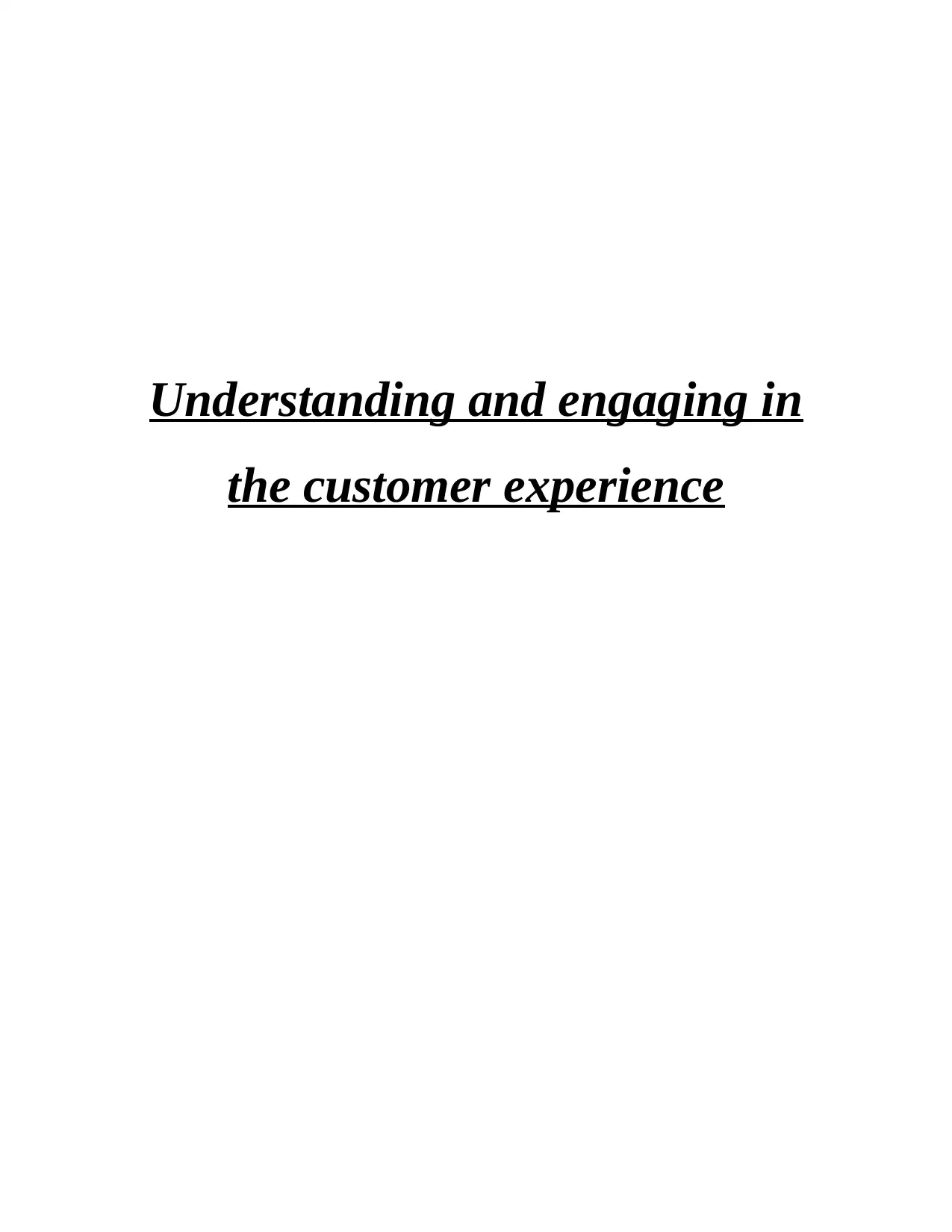
Understanding and engaging in
the customer experience
the customer experience
Secure Best Marks with AI Grader
Need help grading? Try our AI Grader for instant feedback on your assignments.
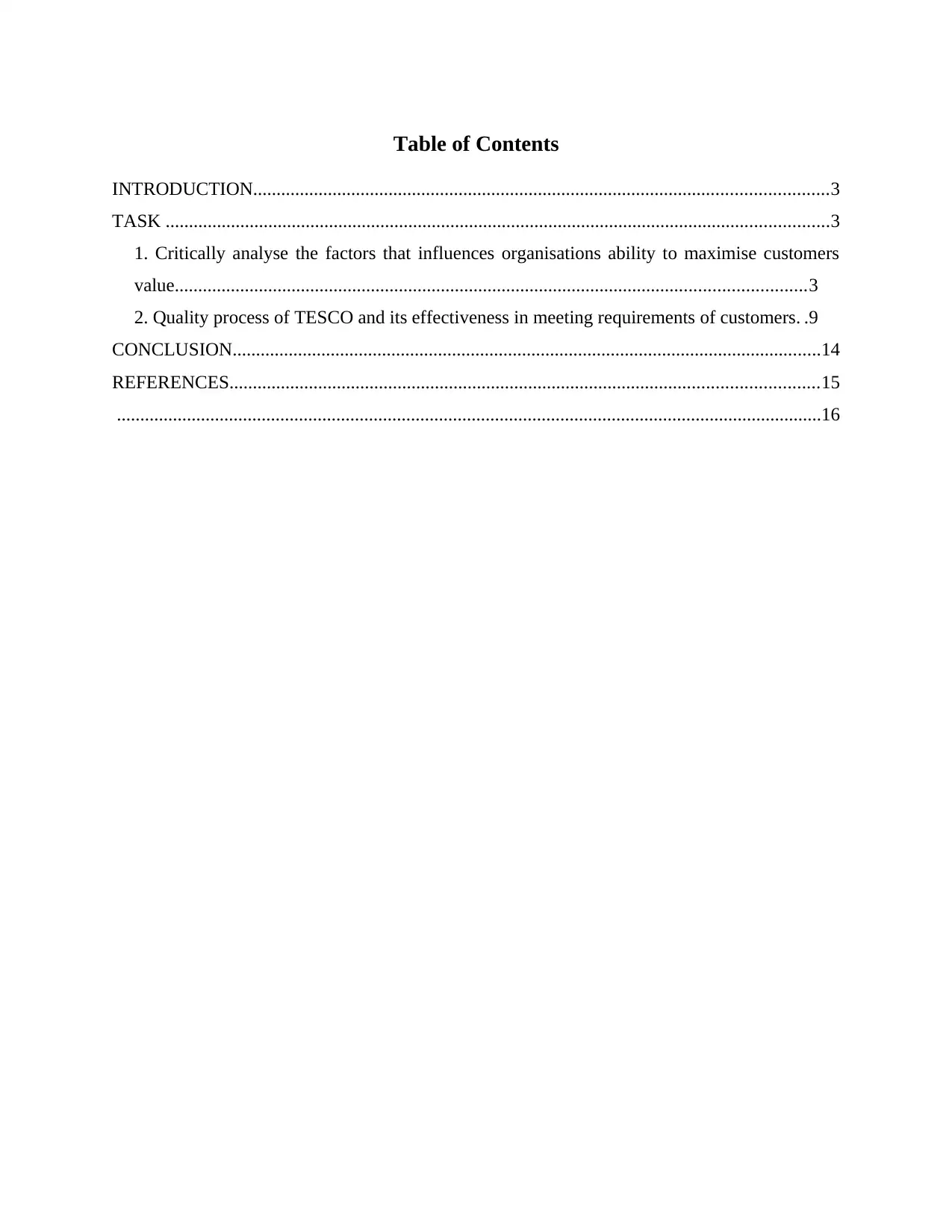
Table of Contents
INTRODUCTION...........................................................................................................................3
TASK ..............................................................................................................................................3
1. Critically analyse the factors that influences organisations ability to maximise customers
value.......................................................................................................................................3
2. Quality process of TESCO and its effectiveness in meeting requirements of customers. .9
CONCLUSION..............................................................................................................................14
REFERENCES..............................................................................................................................15
.......................................................................................................................................................16
INTRODUCTION...........................................................................................................................3
TASK ..............................................................................................................................................3
1. Critically analyse the factors that influences organisations ability to maximise customers
value.......................................................................................................................................3
2. Quality process of TESCO and its effectiveness in meeting requirements of customers. .9
CONCLUSION..............................................................................................................................14
REFERENCES..............................................................................................................................15
.......................................................................................................................................................16
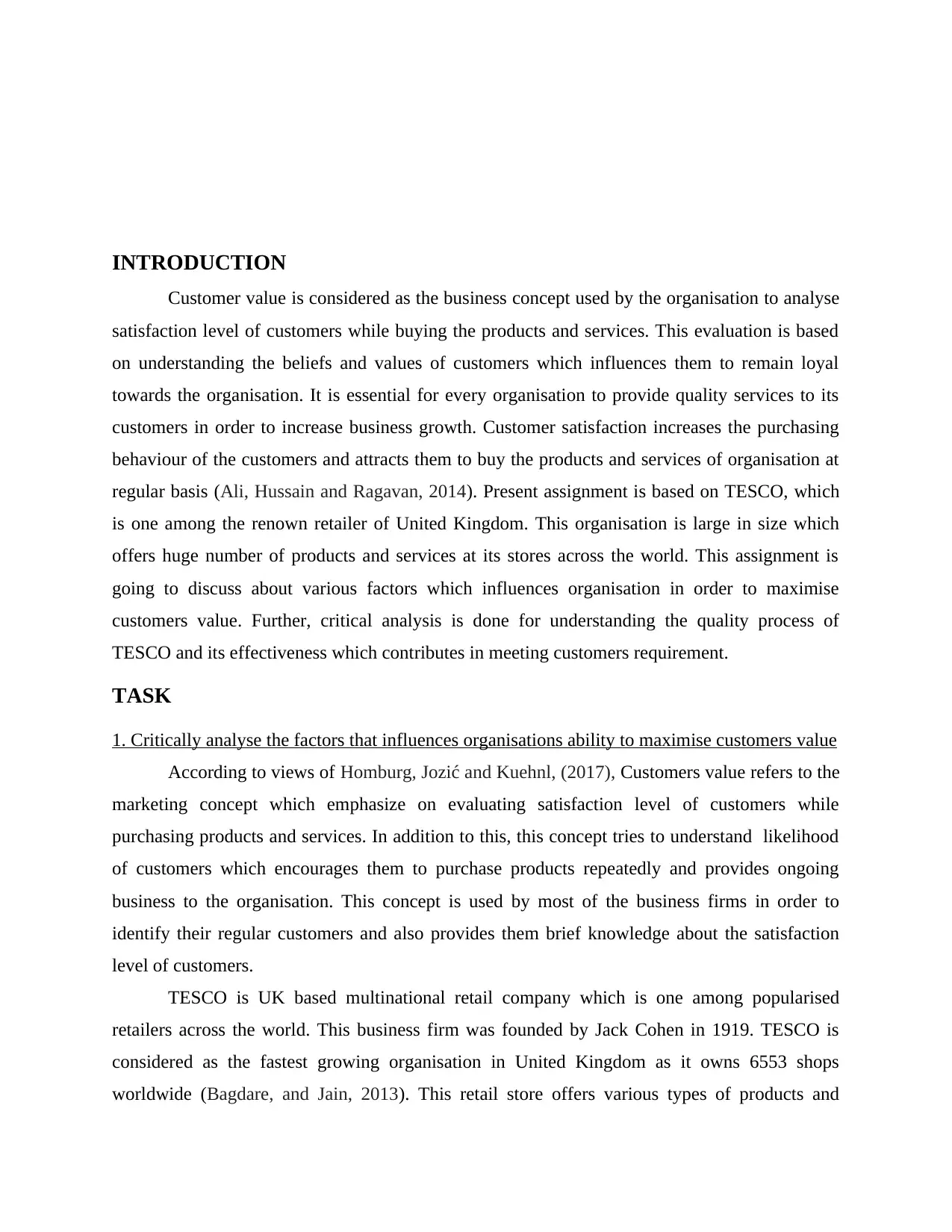
INTRODUCTION
Customer value is considered as the business concept used by the organisation to analyse
satisfaction level of customers while buying the products and services. This evaluation is based
on understanding the beliefs and values of customers which influences them to remain loyal
towards the organisation. It is essential for every organisation to provide quality services to its
customers in order to increase business growth. Customer satisfaction increases the purchasing
behaviour of the customers and attracts them to buy the products and services of organisation at
regular basis (Ali, Hussain and Ragavan, 2014). Present assignment is based on TESCO, which
is one among the renown retailer of United Kingdom. This organisation is large in size which
offers huge number of products and services at its stores across the world. This assignment is
going to discuss about various factors which influences organisation in order to maximise
customers value. Further, critical analysis is done for understanding the quality process of
TESCO and its effectiveness which contributes in meeting customers requirement.
TASK
1. Critically analyse the factors that influences organisations ability to maximise customers value
According to views of Homburg, Jozić and Kuehnl, (2017), Customers value refers to the
marketing concept which emphasize on evaluating satisfaction level of customers while
purchasing products and services. In addition to this, this concept tries to understand likelihood
of customers which encourages them to purchase products repeatedly and provides ongoing
business to the organisation. This concept is used by most of the business firms in order to
identify their regular customers and also provides them brief knowledge about the satisfaction
level of customers.
TESCO is UK based multinational retail company which is one among popularised
retailers across the world. This business firm was founded by Jack Cohen in 1919. TESCO is
considered as the fastest growing organisation in United Kingdom as it owns 6553 shops
worldwide (Bagdare, and Jain, 2013). This retail store offers various types of products and
Customer value is considered as the business concept used by the organisation to analyse
satisfaction level of customers while buying the products and services. This evaluation is based
on understanding the beliefs and values of customers which influences them to remain loyal
towards the organisation. It is essential for every organisation to provide quality services to its
customers in order to increase business growth. Customer satisfaction increases the purchasing
behaviour of the customers and attracts them to buy the products and services of organisation at
regular basis (Ali, Hussain and Ragavan, 2014). Present assignment is based on TESCO, which
is one among the renown retailer of United Kingdom. This organisation is large in size which
offers huge number of products and services at its stores across the world. This assignment is
going to discuss about various factors which influences organisation in order to maximise
customers value. Further, critical analysis is done for understanding the quality process of
TESCO and its effectiveness which contributes in meeting customers requirement.
TASK
1. Critically analyse the factors that influences organisations ability to maximise customers value
According to views of Homburg, Jozić and Kuehnl, (2017), Customers value refers to the
marketing concept which emphasize on evaluating satisfaction level of customers while
purchasing products and services. In addition to this, this concept tries to understand likelihood
of customers which encourages them to purchase products repeatedly and provides ongoing
business to the organisation. This concept is used by most of the business firms in order to
identify their regular customers and also provides them brief knowledge about the satisfaction
level of customers.
TESCO is UK based multinational retail company which is one among popularised
retailers across the world. This business firm was founded by Jack Cohen in 1919. TESCO is
considered as the fastest growing organisation in United Kingdom as it owns 6553 shops
worldwide (Bagdare, and Jain, 2013). This retail store offers various types of products and
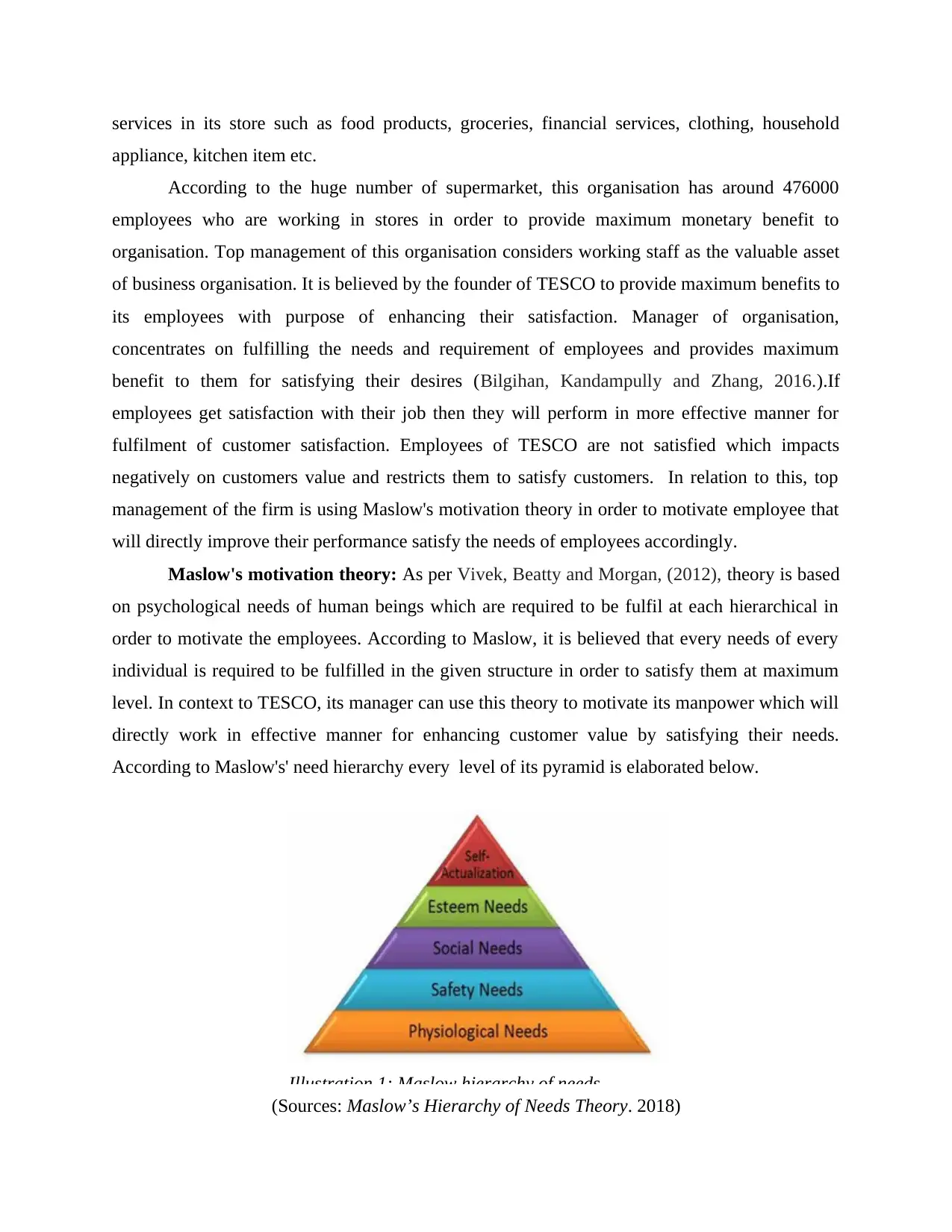
services in its store such as food products, groceries, financial services, clothing, household
appliance, kitchen item etc.
According to the huge number of supermarket, this organisation has around 476000
employees who are working in stores in order to provide maximum monetary benefit to
organisation. Top management of this organisation considers working staff as the valuable asset
of business organisation. It is believed by the founder of TESCO to provide maximum benefits to
its employees with purpose of enhancing their satisfaction. Manager of organisation,
concentrates on fulfilling the needs and requirement of employees and provides maximum
benefit to them for satisfying their desires (Bilgihan, Kandampully and Zhang, 2016.).If
employees get satisfaction with their job then they will perform in more effective manner for
fulfilment of customer satisfaction. Employees of TESCO are not satisfied which impacts
negatively on customers value and restricts them to satisfy customers. In relation to this, top
management of the firm is using Maslow's motivation theory in order to motivate employee that
will directly improve their performance satisfy the needs of employees accordingly.
Maslow's motivation theory: As per Vivek, Beatty and Morgan, (2012), theory is based
on psychological needs of human beings which are required to be fulfil at each hierarchical in
order to motivate the employees. According to Maslow, it is believed that every needs of every
individual is required to be fulfilled in the given structure in order to satisfy them at maximum
level. In context to TESCO, its manager can use this theory to motivate its manpower which will
directly work in effective manner for enhancing customer value by satisfying their needs.
According to Maslow's' need hierarchy every level of its pyramid is elaborated below.
(Sources: Maslow’s Hierarchy of Needs Theory. 2018)
Illustration 1: Maslow hierarchy of needs
appliance, kitchen item etc.
According to the huge number of supermarket, this organisation has around 476000
employees who are working in stores in order to provide maximum monetary benefit to
organisation. Top management of this organisation considers working staff as the valuable asset
of business organisation. It is believed by the founder of TESCO to provide maximum benefits to
its employees with purpose of enhancing their satisfaction. Manager of organisation,
concentrates on fulfilling the needs and requirement of employees and provides maximum
benefit to them for satisfying their desires (Bilgihan, Kandampully and Zhang, 2016.).If
employees get satisfaction with their job then they will perform in more effective manner for
fulfilment of customer satisfaction. Employees of TESCO are not satisfied which impacts
negatively on customers value and restricts them to satisfy customers. In relation to this, top
management of the firm is using Maslow's motivation theory in order to motivate employee that
will directly improve their performance satisfy the needs of employees accordingly.
Maslow's motivation theory: As per Vivek, Beatty and Morgan, (2012), theory is based
on psychological needs of human beings which are required to be fulfil at each hierarchical in
order to motivate the employees. According to Maslow, it is believed that every needs of every
individual is required to be fulfilled in the given structure in order to satisfy them at maximum
level. In context to TESCO, its manager can use this theory to motivate its manpower which will
directly work in effective manner for enhancing customer value by satisfying their needs.
According to Maslow's' need hierarchy every level of its pyramid is elaborated below.
(Sources: Maslow’s Hierarchy of Needs Theory. 2018)
Illustration 1: Maslow hierarchy of needs
Secure Best Marks with AI Grader
Need help grading? Try our AI Grader for instant feedback on your assignments.
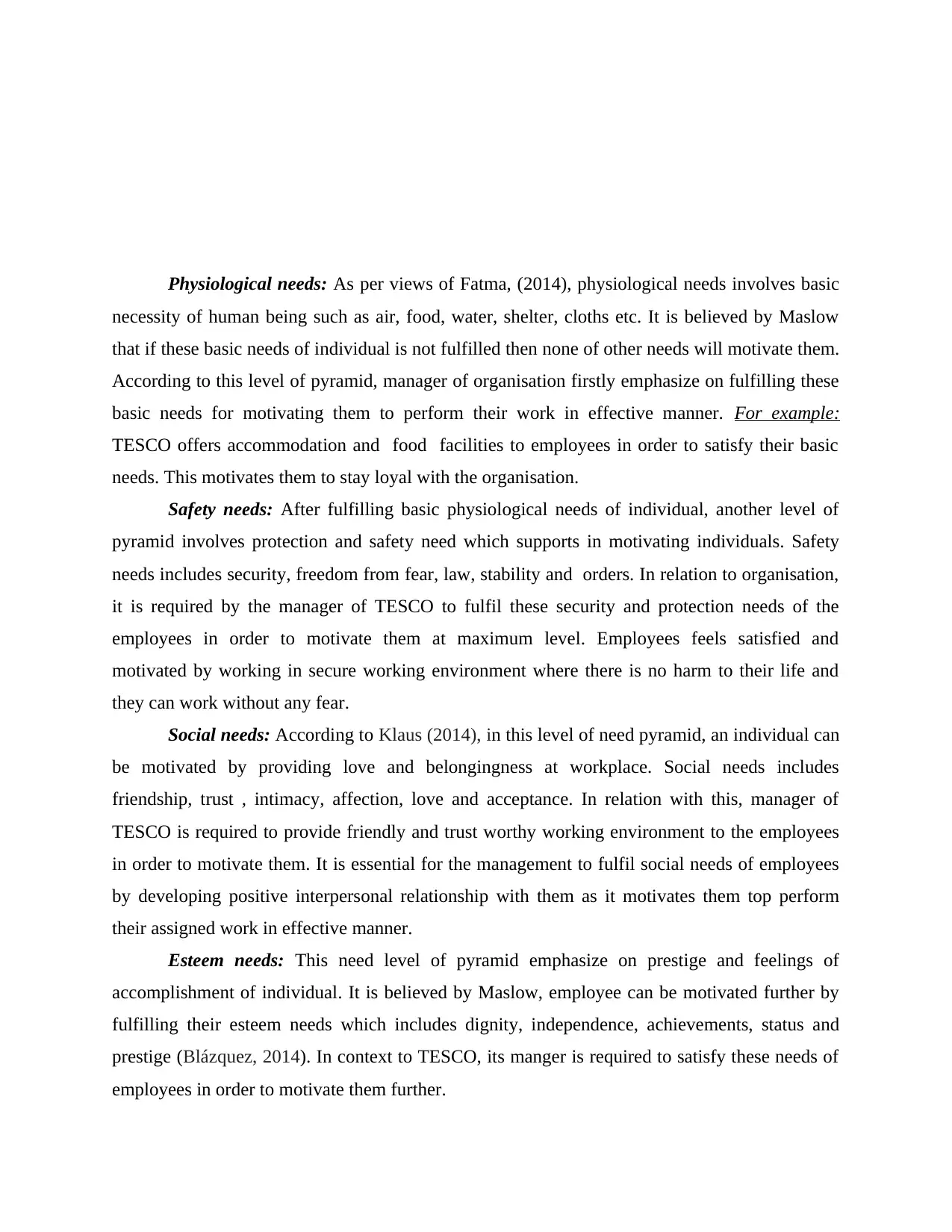
Physiological needs: As per views of Fatma, (2014), physiological needs involves basic
necessity of human being such as air, food, water, shelter, cloths etc. It is believed by Maslow
that if these basic needs of individual is not fulfilled then none of other needs will motivate them.
According to this level of pyramid, manager of organisation firstly emphasize on fulfilling these
basic needs for motivating them to perform their work in effective manner. For example:
TESCO offers accommodation and food facilities to employees in order to satisfy their basic
needs. This motivates them to stay loyal with the organisation.
Safety needs: After fulfilling basic physiological needs of individual, another level of
pyramid involves protection and safety need which supports in motivating individuals. Safety
needs includes security, freedom from fear, law, stability and orders. In relation to organisation,
it is required by the manager of TESCO to fulfil these security and protection needs of the
employees in order to motivate them at maximum level. Employees feels satisfied and
motivated by working in secure working environment where there is no harm to their life and
they can work without any fear.
Social needs: According to Klaus (2014), in this level of need pyramid, an individual can
be motivated by providing love and belongingness at workplace. Social needs includes
friendship, trust , intimacy, affection, love and acceptance. In relation with this, manager of
TESCO is required to provide friendly and trust worthy working environment to the employees
in order to motivate them. It is essential for the management to fulfil social needs of employees
by developing positive interpersonal relationship with them as it motivates them top perform
their assigned work in effective manner.
Esteem needs: This need level of pyramid emphasize on prestige and feelings of
accomplishment of individual. It is believed by Maslow, employee can be motivated further by
fulfilling their esteem needs which includes dignity, independence, achievements, status and
prestige (Blázquez, 2014). In context to TESCO, its manger is required to satisfy these needs of
employees in order to motivate them further.
necessity of human being such as air, food, water, shelter, cloths etc. It is believed by Maslow
that if these basic needs of individual is not fulfilled then none of other needs will motivate them.
According to this level of pyramid, manager of organisation firstly emphasize on fulfilling these
basic needs for motivating them to perform their work in effective manner. For example:
TESCO offers accommodation and food facilities to employees in order to satisfy their basic
needs. This motivates them to stay loyal with the organisation.
Safety needs: After fulfilling basic physiological needs of individual, another level of
pyramid involves protection and safety need which supports in motivating individuals. Safety
needs includes security, freedom from fear, law, stability and orders. In relation to organisation,
it is required by the manager of TESCO to fulfil these security and protection needs of the
employees in order to motivate them at maximum level. Employees feels satisfied and
motivated by working in secure working environment where there is no harm to their life and
they can work without any fear.
Social needs: According to Klaus (2014), in this level of need pyramid, an individual can
be motivated by providing love and belongingness at workplace. Social needs includes
friendship, trust , intimacy, affection, love and acceptance. In relation with this, manager of
TESCO is required to provide friendly and trust worthy working environment to the employees
in order to motivate them. It is essential for the management to fulfil social needs of employees
by developing positive interpersonal relationship with them as it motivates them top perform
their assigned work in effective manner.
Esteem needs: This need level of pyramid emphasize on prestige and feelings of
accomplishment of individual. It is believed by Maslow, employee can be motivated further by
fulfilling their esteem needs which includes dignity, independence, achievements, status and
prestige (Blázquez, 2014). In context to TESCO, its manger is required to satisfy these needs of
employees in order to motivate them further.
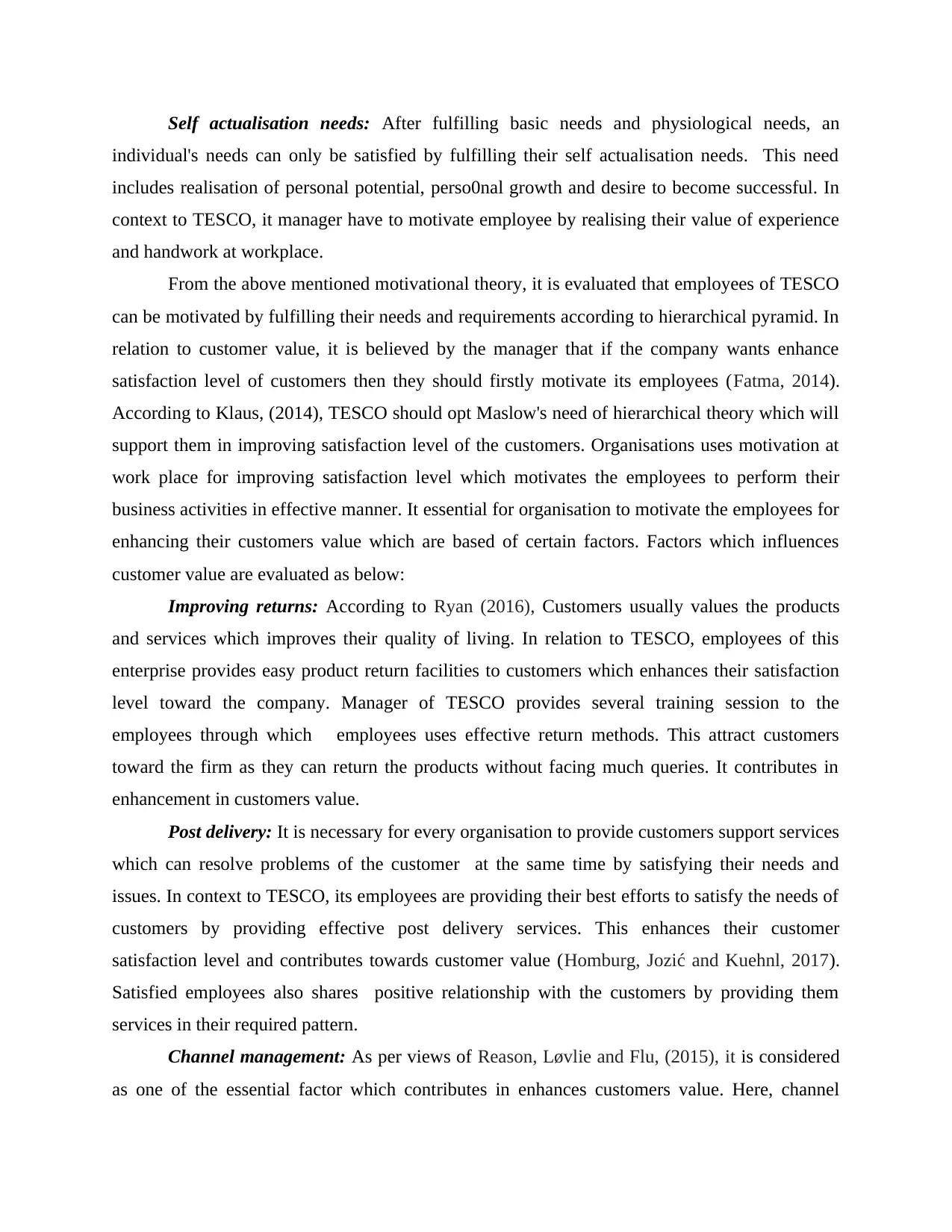
Self actualisation needs: After fulfilling basic needs and physiological needs, an
individual's needs can only be satisfied by fulfilling their self actualisation needs. This need
includes realisation of personal potential, perso0nal growth and desire to become successful. In
context to TESCO, it manager have to motivate employee by realising their value of experience
and handwork at workplace.
From the above mentioned motivational theory, it is evaluated that employees of TESCO
can be motivated by fulfilling their needs and requirements according to hierarchical pyramid. In
relation to customer value, it is believed by the manager that if the company wants enhance
satisfaction level of customers then they should firstly motivate its employees (Fatma, 2014).
According to Klaus, (2014), TESCO should opt Maslow's need of hierarchical theory which will
support them in improving satisfaction level of the customers. Organisations uses motivation at
work place for improving satisfaction level which motivates the employees to perform their
business activities in effective manner. It essential for organisation to motivate the employees for
enhancing their customers value which are based of certain factors. Factors which influences
customer value are evaluated as below:
Improving returns: According to Ryan (2016), Customers usually values the products
and services which improves their quality of living. In relation to TESCO, employees of this
enterprise provides easy product return facilities to customers which enhances their satisfaction
level toward the company. Manager of TESCO provides several training session to the
employees through which employees uses effective return methods. This attract customers
toward the firm as they can return the products without facing much queries. It contributes in
enhancement in customers value.
Post delivery: It is necessary for every organisation to provide customers support services
which can resolve problems of the customer at the same time by satisfying their needs and
issues. In context to TESCO, its employees are providing their best efforts to satisfy the needs of
customers by providing effective post delivery services. This enhances their customer
satisfaction level and contributes towards customer value (Homburg, Jozić and Kuehnl, 2017).
Satisfied employees also shares positive relationship with the customers by providing them
services in their required pattern.
Channel management: As per views of Reason, Løvlie and Flu, (2015), it is considered
as one of the essential factor which contributes in enhances customers value. Here, channel
individual's needs can only be satisfied by fulfilling their self actualisation needs. This need
includes realisation of personal potential, perso0nal growth and desire to become successful. In
context to TESCO, it manager have to motivate employee by realising their value of experience
and handwork at workplace.
From the above mentioned motivational theory, it is evaluated that employees of TESCO
can be motivated by fulfilling their needs and requirements according to hierarchical pyramid. In
relation to customer value, it is believed by the manager that if the company wants enhance
satisfaction level of customers then they should firstly motivate its employees (Fatma, 2014).
According to Klaus, (2014), TESCO should opt Maslow's need of hierarchical theory which will
support them in improving satisfaction level of the customers. Organisations uses motivation at
work place for improving satisfaction level which motivates the employees to perform their
business activities in effective manner. It essential for organisation to motivate the employees for
enhancing their customers value which are based of certain factors. Factors which influences
customer value are evaluated as below:
Improving returns: According to Ryan (2016), Customers usually values the products
and services which improves their quality of living. In relation to TESCO, employees of this
enterprise provides easy product return facilities to customers which enhances their satisfaction
level toward the company. Manager of TESCO provides several training session to the
employees through which employees uses effective return methods. This attract customers
toward the firm as they can return the products without facing much queries. It contributes in
enhancement in customers value.
Post delivery: It is necessary for every organisation to provide customers support services
which can resolve problems of the customer at the same time by satisfying their needs and
issues. In context to TESCO, its employees are providing their best efforts to satisfy the needs of
customers by providing effective post delivery services. This enhances their customer
satisfaction level and contributes towards customer value (Homburg, Jozić and Kuehnl, 2017).
Satisfied employees also shares positive relationship with the customers by providing them
services in their required pattern.
Channel management: As per views of Reason, Løvlie and Flu, (2015), it is considered
as one of the essential factor which contributes in enhances customers value. Here, channel
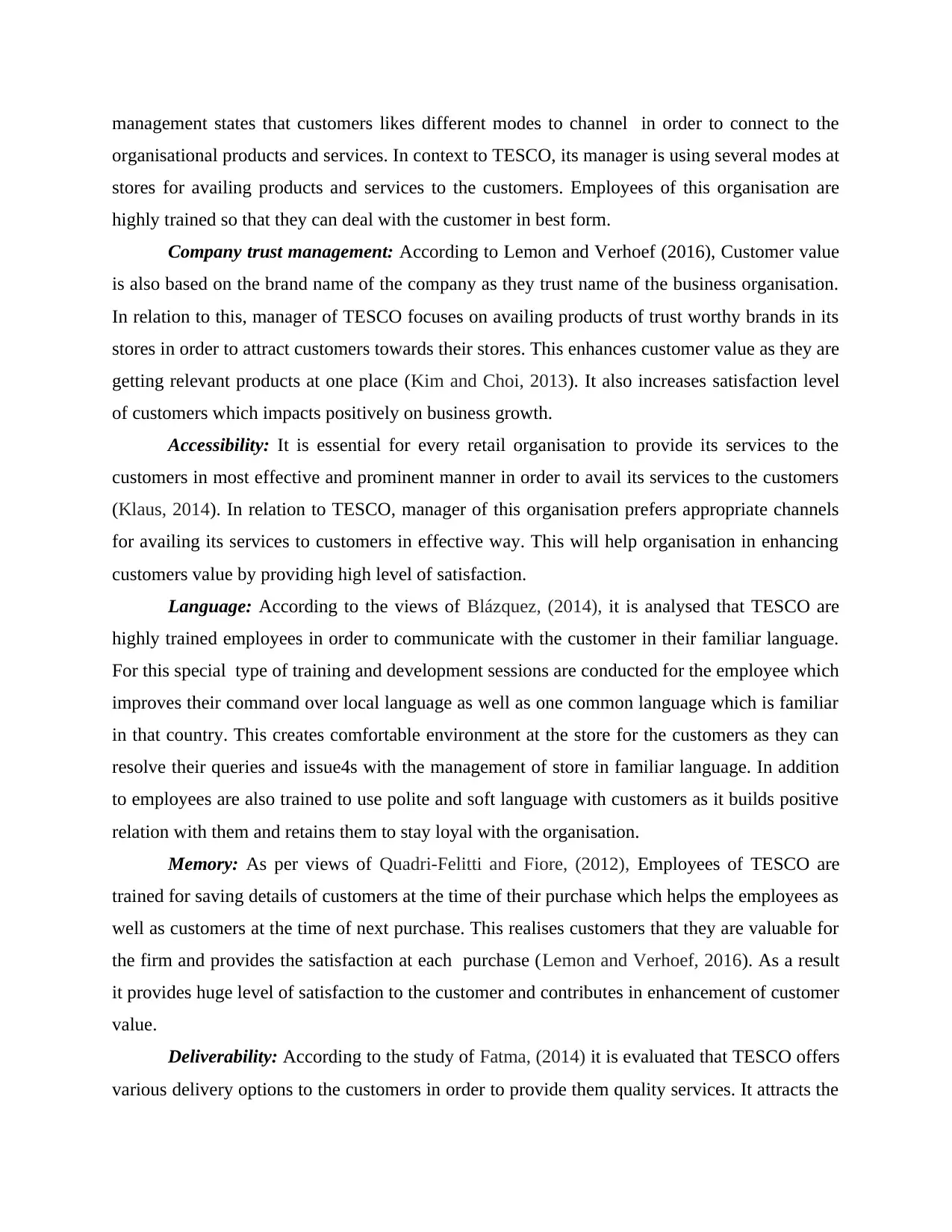
management states that customers likes different modes to channel in order to connect to the
organisational products and services. In context to TESCO, its manager is using several modes at
stores for availing products and services to the customers. Employees of this organisation are
highly trained so that they can deal with the customer in best form.
Company trust management: According to Lemon and Verhoef (2016), Customer value
is also based on the brand name of the company as they trust name of the business organisation.
In relation to this, manager of TESCO focuses on availing products of trust worthy brands in its
stores in order to attract customers towards their stores. This enhances customer value as they are
getting relevant products at one place (Kim and Choi, 2013). It also increases satisfaction level
of customers which impacts positively on business growth.
Accessibility: It is essential for every retail organisation to provide its services to the
customers in most effective and prominent manner in order to avail its services to the customers
(Klaus, 2014). In relation to TESCO, manager of this organisation prefers appropriate channels
for availing its services to customers in effective way. This will help organisation in enhancing
customers value by providing high level of satisfaction.
Language: According to the views of Blázquez, (2014), it is analysed that TESCO are
highly trained employees in order to communicate with the customer in their familiar language.
For this special type of training and development sessions are conducted for the employee which
improves their command over local language as well as one common language which is familiar
in that country. This creates comfortable environment at the store for the customers as they can
resolve their queries and issue4s with the management of store in familiar language. In addition
to employees are also trained to use polite and soft language with customers as it builds positive
relation with them and retains them to stay loyal with the organisation.
Memory: As per views of Quadri-Felitti and Fiore, (2012), Employees of TESCO are
trained for saving details of customers at the time of their purchase which helps the employees as
well as customers at the time of next purchase. This realises customers that they are valuable for
the firm and provides the satisfaction at each purchase (Lemon and Verhoef, 2016). As a result
it provides huge level of satisfaction to the customer and contributes in enhancement of customer
value.
Deliverability: According to the study of Fatma, (2014) it is evaluated that TESCO offers
various delivery options to the customers in order to provide them quality services. It attracts the
organisational products and services. In context to TESCO, its manager is using several modes at
stores for availing products and services to the customers. Employees of this organisation are
highly trained so that they can deal with the customer in best form.
Company trust management: According to Lemon and Verhoef (2016), Customer value
is also based on the brand name of the company as they trust name of the business organisation.
In relation to this, manager of TESCO focuses on availing products of trust worthy brands in its
stores in order to attract customers towards their stores. This enhances customer value as they are
getting relevant products at one place (Kim and Choi, 2013). It also increases satisfaction level
of customers which impacts positively on business growth.
Accessibility: It is essential for every retail organisation to provide its services to the
customers in most effective and prominent manner in order to avail its services to the customers
(Klaus, 2014). In relation to TESCO, manager of this organisation prefers appropriate channels
for availing its services to customers in effective way. This will help organisation in enhancing
customers value by providing high level of satisfaction.
Language: According to the views of Blázquez, (2014), it is analysed that TESCO are
highly trained employees in order to communicate with the customer in their familiar language.
For this special type of training and development sessions are conducted for the employee which
improves their command over local language as well as one common language which is familiar
in that country. This creates comfortable environment at the store for the customers as they can
resolve their queries and issue4s with the management of store in familiar language. In addition
to employees are also trained to use polite and soft language with customers as it builds positive
relation with them and retains them to stay loyal with the organisation.
Memory: As per views of Quadri-Felitti and Fiore, (2012), Employees of TESCO are
trained for saving details of customers at the time of their purchase which helps the employees as
well as customers at the time of next purchase. This realises customers that they are valuable for
the firm and provides the satisfaction at each purchase (Lemon and Verhoef, 2016). As a result
it provides huge level of satisfaction to the customer and contributes in enhancement of customer
value.
Deliverability: According to the study of Fatma, (2014) it is evaluated that TESCO offers
various delivery options to the customers in order to provide them quality services. It attracts the
Paraphrase This Document
Need a fresh take? Get an instant paraphrase of this document with our AI Paraphraser
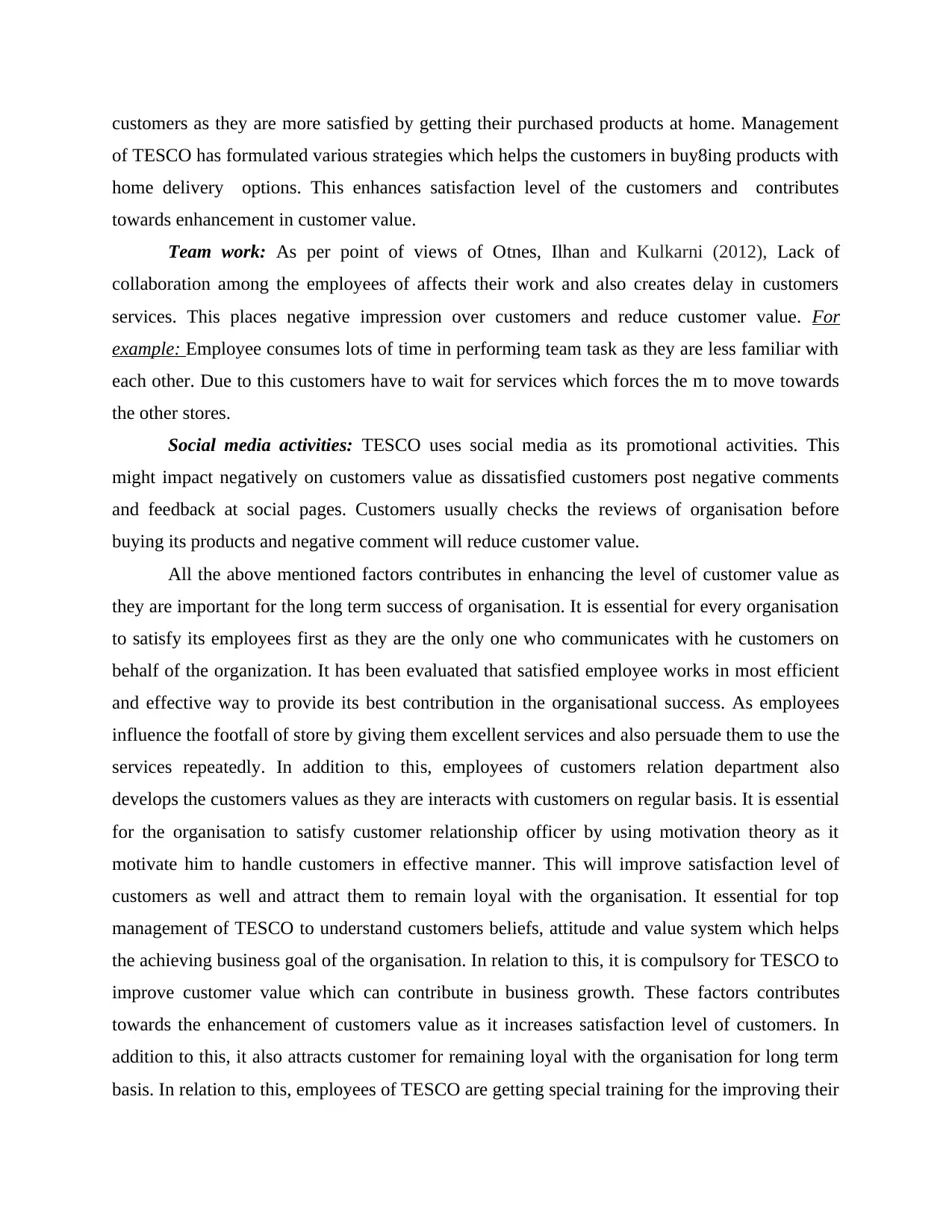
customers as they are more satisfied by getting their purchased products at home. Management
of TESCO has formulated various strategies which helps the customers in buy8ing products with
home delivery options. This enhances satisfaction level of the customers and contributes
towards enhancement in customer value.
Team work: As per point of views of Otnes, Ilhan and Kulkarni (2012), Lack of
collaboration among the employees of affects their work and also creates delay in customers
services. This places negative impression over customers and reduce customer value. For
example: Employee consumes lots of time in performing team task as they are less familiar with
each other. Due to this customers have to wait for services which forces the m to move towards
the other stores.
Social media activities: TESCO uses social media as its promotional activities. This
might impact negatively on customers value as dissatisfied customers post negative comments
and feedback at social pages. Customers usually checks the reviews of organisation before
buying its products and negative comment will reduce customer value.
All the above mentioned factors contributes in enhancing the level of customer value as
they are important for the long term success of organisation. It is essential for every organisation
to satisfy its employees first as they are the only one who communicates with he customers on
behalf of the organization. It has been evaluated that satisfied employee works in most efficient
and effective way to provide its best contribution in the organisational success. As employees
influence the footfall of store by giving them excellent services and also persuade them to use the
services repeatedly. In addition to this, employees of customers relation department also
develops the customers values as they are interacts with customers on regular basis. It is essential
for the organisation to satisfy customer relationship officer by using motivation theory as it
motivate him to handle customers in effective manner. This will improve satisfaction level of
customers as well and attract them to remain loyal with the organisation. It essential for top
management of TESCO to understand customers beliefs, attitude and value system which helps
the achieving business goal of the organisation. In relation to this, it is compulsory for TESCO to
improve customer value which can contribute in business growth. These factors contributes
towards the enhancement of customers value as it increases satisfaction level of customers. In
addition to this, it also attracts customer for remaining loyal with the organisation for long term
basis. In relation to this, employees of TESCO are getting special training for the improving their
of TESCO has formulated various strategies which helps the customers in buy8ing products with
home delivery options. This enhances satisfaction level of the customers and contributes
towards enhancement in customer value.
Team work: As per point of views of Otnes, Ilhan and Kulkarni (2012), Lack of
collaboration among the employees of affects their work and also creates delay in customers
services. This places negative impression over customers and reduce customer value. For
example: Employee consumes lots of time in performing team task as they are less familiar with
each other. Due to this customers have to wait for services which forces the m to move towards
the other stores.
Social media activities: TESCO uses social media as its promotional activities. This
might impact negatively on customers value as dissatisfied customers post negative comments
and feedback at social pages. Customers usually checks the reviews of organisation before
buying its products and negative comment will reduce customer value.
All the above mentioned factors contributes in enhancing the level of customer value as
they are important for the long term success of organisation. It is essential for every organisation
to satisfy its employees first as they are the only one who communicates with he customers on
behalf of the organization. It has been evaluated that satisfied employee works in most efficient
and effective way to provide its best contribution in the organisational success. As employees
influence the footfall of store by giving them excellent services and also persuade them to use the
services repeatedly. In addition to this, employees of customers relation department also
develops the customers values as they are interacts with customers on regular basis. It is essential
for the organisation to satisfy customer relationship officer by using motivation theory as it
motivate him to handle customers in effective manner. This will improve satisfaction level of
customers as well and attract them to remain loyal with the organisation. It essential for top
management of TESCO to understand customers beliefs, attitude and value system which helps
the achieving business goal of the organisation. In relation to this, it is compulsory for TESCO to
improve customer value which can contribute in business growth. These factors contributes
towards the enhancement of customers value as it increases satisfaction level of customers. In
addition to this, it also attracts customer for remaining loyal with the organisation for long term
basis. In relation to this, employees of TESCO are getting special training for the improving their
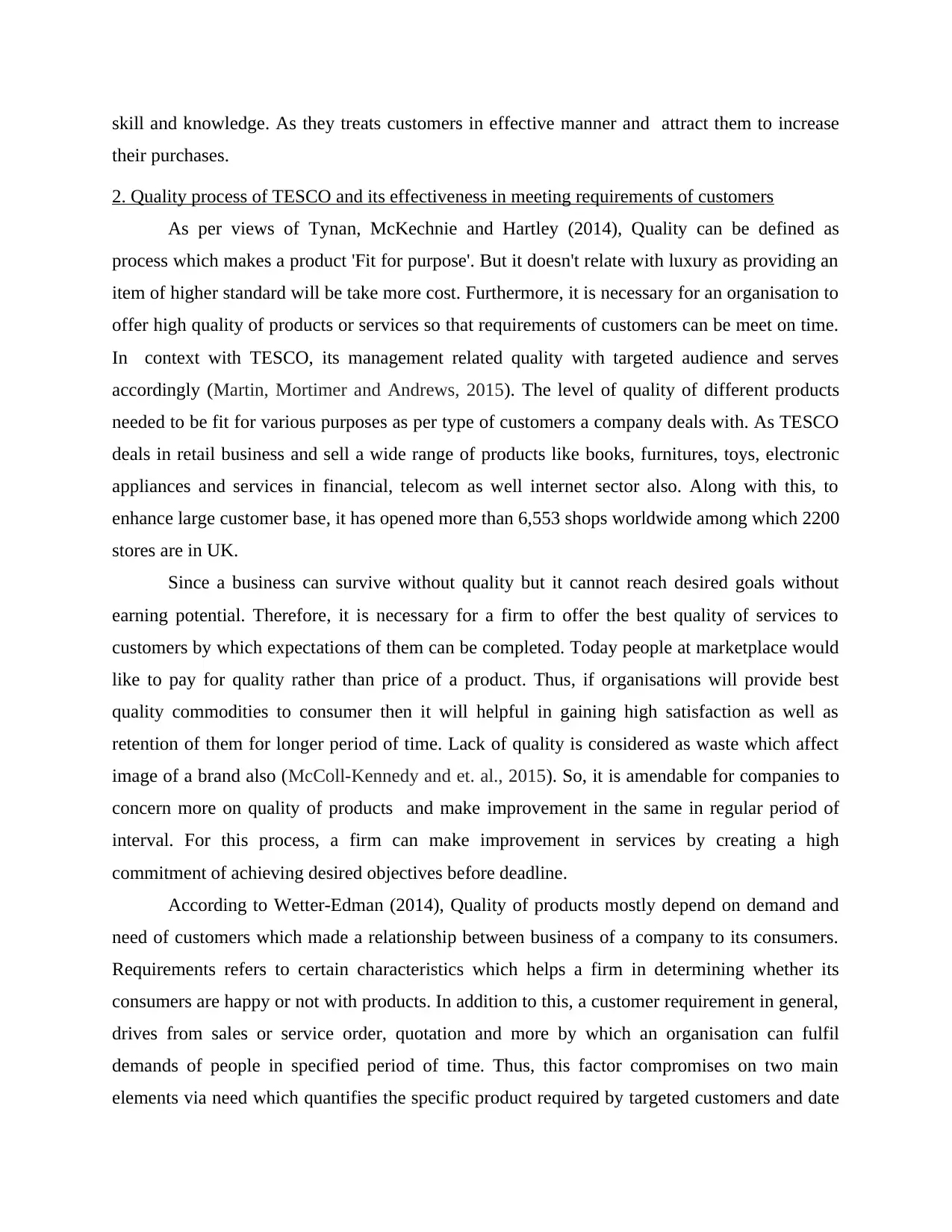
skill and knowledge. As they treats customers in effective manner and attract them to increase
their purchases.
2. Quality process of TESCO and its effectiveness in meeting requirements of customers
As per views of Tynan, McKechnie and Hartley (2014), Quality can be defined as
process which makes a product 'Fit for purpose'. But it doesn't relate with luxury as providing an
item of higher standard will be take more cost. Furthermore, it is necessary for an organisation to
offer high quality of products or services so that requirements of customers can be meet on time.
In context with TESCO, its management related quality with targeted audience and serves
accordingly (Martin, Mortimer and Andrews, 2015). The level of quality of different products
needed to be fit for various purposes as per type of customers a company deals with. As TESCO
deals in retail business and sell a wide range of products like books, furnitures, toys, electronic
appliances and services in financial, telecom as well internet sector also. Along with this, to
enhance large customer base, it has opened more than 6,553 shops worldwide among which 2200
stores are in UK.
Since a business can survive without quality but it cannot reach desired goals without
earning potential. Therefore, it is necessary for a firm to offer the best quality of services to
customers by which expectations of them can be completed. Today people at marketplace would
like to pay for quality rather than price of a product. Thus, if organisations will provide best
quality commodities to consumer then it will helpful in gaining high satisfaction as well as
retention of them for longer period of time. Lack of quality is considered as waste which affect
image of a brand also (McColl-Kennedy and et. al., 2015). So, it is amendable for companies to
concern more on quality of products and make improvement in the same in regular period of
interval. For this process, a firm can make improvement in services by creating a high
commitment of achieving desired objectives before deadline.
According to Wetter-Edman (2014), Quality of products mostly depend on demand and
need of customers which made a relationship between business of a company to its consumers.
Requirements refers to certain characteristics which helps a firm in determining whether its
consumers are happy or not with products. In addition to this, a customer requirement in general,
drives from sales or service order, quotation and more by which an organisation can fulfil
demands of people in specified period of time. Thus, this factor compromises on two main
elements via need which quantifies the specific product required by targeted customers and date
their purchases.
2. Quality process of TESCO and its effectiveness in meeting requirements of customers
As per views of Tynan, McKechnie and Hartley (2014), Quality can be defined as
process which makes a product 'Fit for purpose'. But it doesn't relate with luxury as providing an
item of higher standard will be take more cost. Furthermore, it is necessary for an organisation to
offer high quality of products or services so that requirements of customers can be meet on time.
In context with TESCO, its management related quality with targeted audience and serves
accordingly (Martin, Mortimer and Andrews, 2015). The level of quality of different products
needed to be fit for various purposes as per type of customers a company deals with. As TESCO
deals in retail business and sell a wide range of products like books, furnitures, toys, electronic
appliances and services in financial, telecom as well internet sector also. Along with this, to
enhance large customer base, it has opened more than 6,553 shops worldwide among which 2200
stores are in UK.
Since a business can survive without quality but it cannot reach desired goals without
earning potential. Therefore, it is necessary for a firm to offer the best quality of services to
customers by which expectations of them can be completed. Today people at marketplace would
like to pay for quality rather than price of a product. Thus, if organisations will provide best
quality commodities to consumer then it will helpful in gaining high satisfaction as well as
retention of them for longer period of time. Lack of quality is considered as waste which affect
image of a brand also (McColl-Kennedy and et. al., 2015). So, it is amendable for companies to
concern more on quality of products and make improvement in the same in regular period of
interval. For this process, a firm can make improvement in services by creating a high
commitment of achieving desired objectives before deadline.
According to Wetter-Edman (2014), Quality of products mostly depend on demand and
need of customers which made a relationship between business of a company to its consumers.
Requirements refers to certain characteristics which helps a firm in determining whether its
consumers are happy or not with products. In addition to this, a customer requirement in general,
drives from sales or service order, quotation and more by which an organisation can fulfil
demands of people in specified period of time. Thus, this factor compromises on two main
elements via need which quantifies the specific product required by targeted customers and date
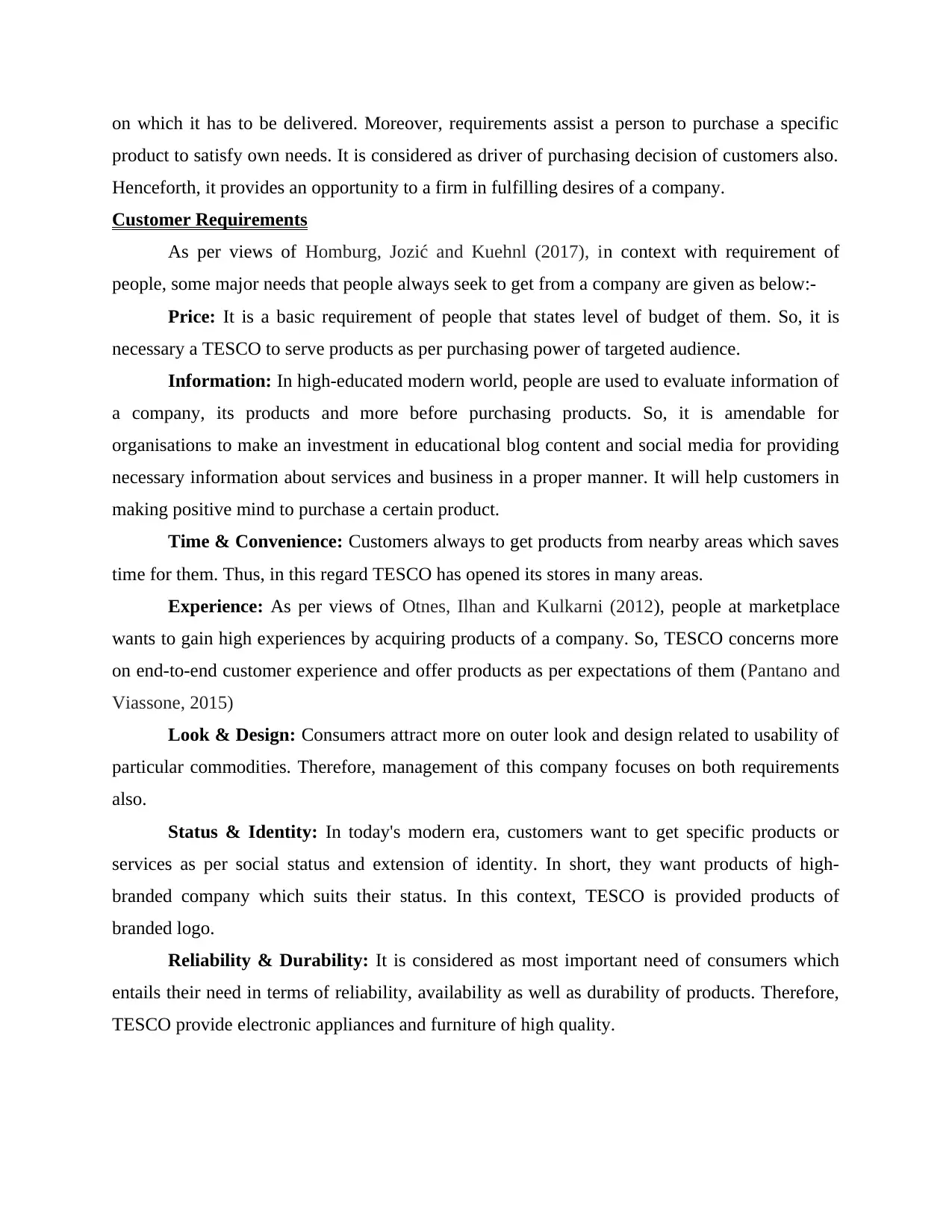
on which it has to be delivered. Moreover, requirements assist a person to purchase a specific
product to satisfy own needs. It is considered as driver of purchasing decision of customers also.
Henceforth, it provides an opportunity to a firm in fulfilling desires of a company.
Customer Requirements
As per views of Homburg, Jozić and Kuehnl (2017), in context with requirement of
people, some major needs that people always seek to get from a company are given as below:-
Price: It is a basic requirement of people that states level of budget of them. So, it is
necessary a TESCO to serve products as per purchasing power of targeted audience.
Information: In high-educated modern world, people are used to evaluate information of
a company, its products and more before purchasing products. So, it is amendable for
organisations to make an investment in educational blog content and social media for providing
necessary information about services and business in a proper manner. It will help customers in
making positive mind to purchase a certain product.
Time & Convenience: Customers always to get products from nearby areas which saves
time for them. Thus, in this regard TESCO has opened its stores in many areas.
Experience: As per views of Otnes, Ilhan and Kulkarni (2012), people at marketplace
wants to gain high experiences by acquiring products of a company. So, TESCO concerns more
on end-to-end customer experience and offer products as per expectations of them (Pantano and
Viassone, 2015)
Look & Design: Consumers attract more on outer look and design related to usability of
particular commodities. Therefore, management of this company focuses on both requirements
also.
Status & Identity: In today's modern era, customers want to get specific products or
services as per social status and extension of identity. In short, they want products of high-
branded company which suits their status. In this context, TESCO is provided products of
branded logo.
Reliability & Durability: It is considered as most important need of consumers which
entails their need in terms of reliability, availability as well as durability of products. Therefore,
TESCO provide electronic appliances and furniture of high quality.
product to satisfy own needs. It is considered as driver of purchasing decision of customers also.
Henceforth, it provides an opportunity to a firm in fulfilling desires of a company.
Customer Requirements
As per views of Homburg, Jozić and Kuehnl (2017), in context with requirement of
people, some major needs that people always seek to get from a company are given as below:-
Price: It is a basic requirement of people that states level of budget of them. So, it is
necessary a TESCO to serve products as per purchasing power of targeted audience.
Information: In high-educated modern world, people are used to evaluate information of
a company, its products and more before purchasing products. So, it is amendable for
organisations to make an investment in educational blog content and social media for providing
necessary information about services and business in a proper manner. It will help customers in
making positive mind to purchase a certain product.
Time & Convenience: Customers always to get products from nearby areas which saves
time for them. Thus, in this regard TESCO has opened its stores in many areas.
Experience: As per views of Otnes, Ilhan and Kulkarni (2012), people at marketplace
wants to gain high experiences by acquiring products of a company. So, TESCO concerns more
on end-to-end customer experience and offer products as per expectations of them (Pantano and
Viassone, 2015)
Look & Design: Consumers attract more on outer look and design related to usability of
particular commodities. Therefore, management of this company focuses on both requirements
also.
Status & Identity: In today's modern era, customers want to get specific products or
services as per social status and extension of identity. In short, they want products of high-
branded company which suits their status. In this context, TESCO is provided products of
branded logo.
Reliability & Durability: It is considered as most important need of consumers which
entails their need in terms of reliability, availability as well as durability of products. Therefore,
TESCO provide electronic appliances and furniture of high quality.
Secure Best Marks with AI Grader
Need help grading? Try our AI Grader for instant feedback on your assignments.
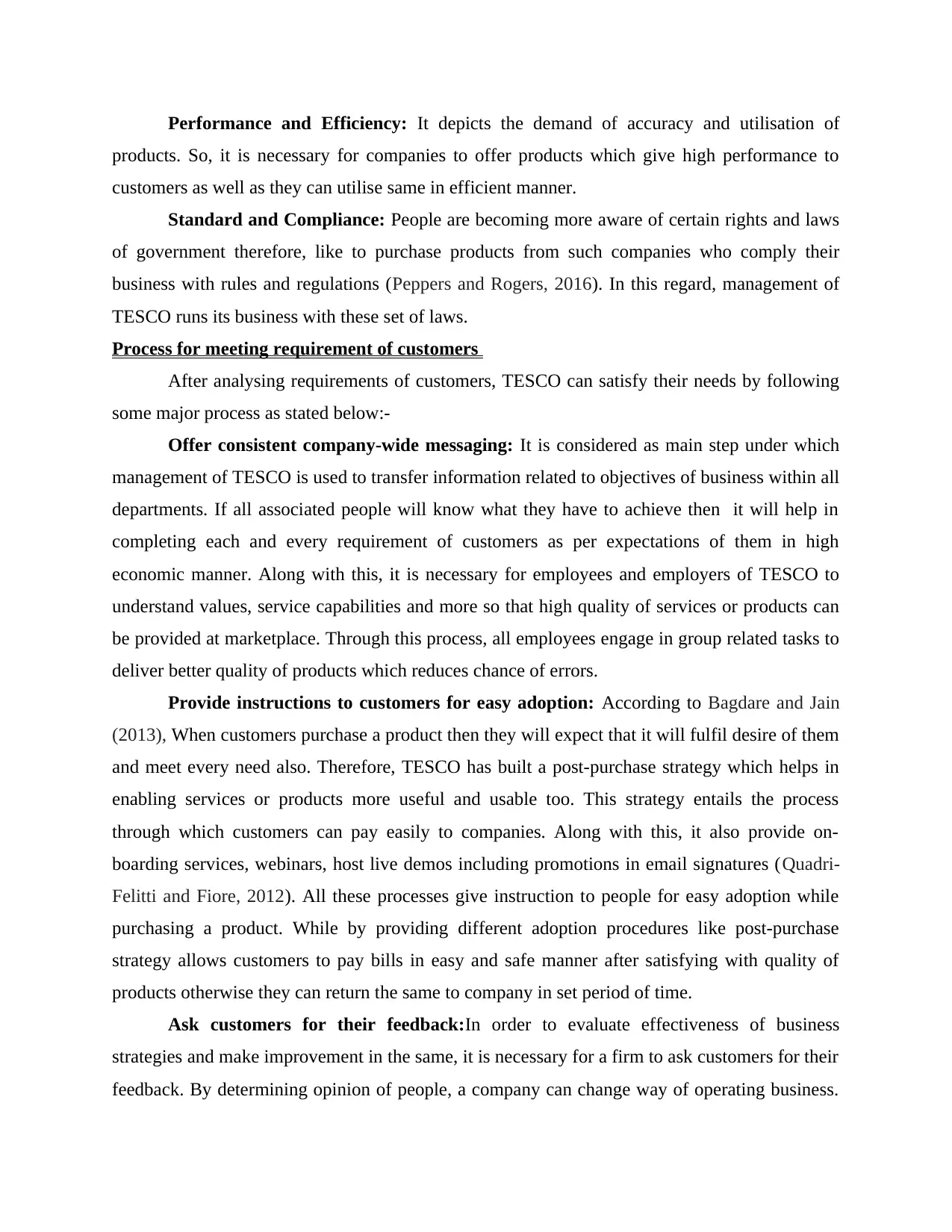
Performance and Efficiency: It depicts the demand of accuracy and utilisation of
products. So, it is necessary for companies to offer products which give high performance to
customers as well as they can utilise same in efficient manner.
Standard and Compliance: People are becoming more aware of certain rights and laws
of government therefore, like to purchase products from such companies who comply their
business with rules and regulations (Peppers and Rogers, 2016). In this regard, management of
TESCO runs its business with these set of laws.
Process for meeting requirement of customers
After analysing requirements of customers, TESCO can satisfy their needs by following
some major process as stated below:-
Offer consistent company-wide messaging: It is considered as main step under which
management of TESCO is used to transfer information related to objectives of business within all
departments. If all associated people will know what they have to achieve then it will help in
completing each and every requirement of customers as per expectations of them in high
economic manner. Along with this, it is necessary for employees and employers of TESCO to
understand values, service capabilities and more so that high quality of services or products can
be provided at marketplace. Through this process, all employees engage in group related tasks to
deliver better quality of products which reduces chance of errors.
Provide instructions to customers for easy adoption: According to Bagdare and Jain
(2013), When customers purchase a product then they will expect that it will fulfil desire of them
and meet every need also. Therefore, TESCO has built a post-purchase strategy which helps in
enabling services or products more useful and usable too. This strategy entails the process
through which customers can pay easily to companies. Along with this, it also provide on-
boarding services, webinars, host live demos including promotions in email signatures (Quadri-
Felitti and Fiore, 2012). All these processes give instruction to people for easy adoption while
purchasing a product. While by providing different adoption procedures like post-purchase
strategy allows customers to pay bills in easy and safe manner after satisfying with quality of
products otherwise they can return the same to company in set period of time.
Ask customers for their feedback:In order to evaluate effectiveness of business
strategies and make improvement in the same, it is necessary for a firm to ask customers for their
feedback. By determining opinion of people, a company can change way of operating business.
products. So, it is necessary for companies to offer products which give high performance to
customers as well as they can utilise same in efficient manner.
Standard and Compliance: People are becoming more aware of certain rights and laws
of government therefore, like to purchase products from such companies who comply their
business with rules and regulations (Peppers and Rogers, 2016). In this regard, management of
TESCO runs its business with these set of laws.
Process for meeting requirement of customers
After analysing requirements of customers, TESCO can satisfy their needs by following
some major process as stated below:-
Offer consistent company-wide messaging: It is considered as main step under which
management of TESCO is used to transfer information related to objectives of business within all
departments. If all associated people will know what they have to achieve then it will help in
completing each and every requirement of customers as per expectations of them in high
economic manner. Along with this, it is necessary for employees and employers of TESCO to
understand values, service capabilities and more so that high quality of services or products can
be provided at marketplace. Through this process, all employees engage in group related tasks to
deliver better quality of products which reduces chance of errors.
Provide instructions to customers for easy adoption: According to Bagdare and Jain
(2013), When customers purchase a product then they will expect that it will fulfil desire of them
and meet every need also. Therefore, TESCO has built a post-purchase strategy which helps in
enabling services or products more useful and usable too. This strategy entails the process
through which customers can pay easily to companies. Along with this, it also provide on-
boarding services, webinars, host live demos including promotions in email signatures (Quadri-
Felitti and Fiore, 2012). All these processes give instruction to people for easy adoption while
purchasing a product. While by providing different adoption procedures like post-purchase
strategy allows customers to pay bills in easy and safe manner after satisfying with quality of
products otherwise they can return the same to company in set period of time.
Ask customers for their feedback:In order to evaluate effectiveness of business
strategies and make improvement in the same, it is necessary for a firm to ask customers for their
feedback. By determining opinion of people, a company can change way of operating business.
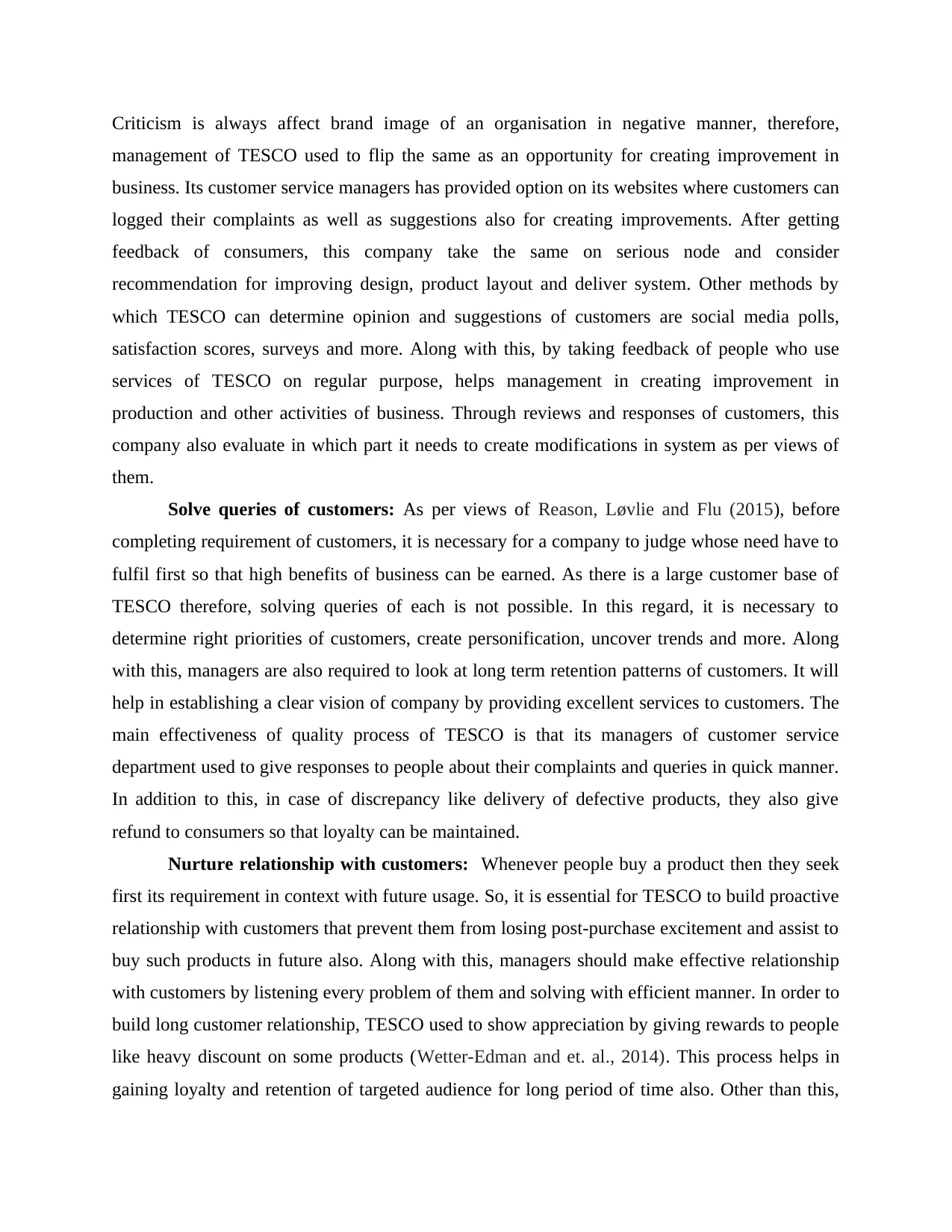
Criticism is always affect brand image of an organisation in negative manner, therefore,
management of TESCO used to flip the same as an opportunity for creating improvement in
business. Its customer service managers has provided option on its websites where customers can
logged their complaints as well as suggestions also for creating improvements. After getting
feedback of consumers, this company take the same on serious node and consider
recommendation for improving design, product layout and deliver system. Other methods by
which TESCO can determine opinion and suggestions of customers are social media polls,
satisfaction scores, surveys and more. Along with this, by taking feedback of people who use
services of TESCO on regular purpose, helps management in creating improvement in
production and other activities of business. Through reviews and responses of customers, this
company also evaluate in which part it needs to create modifications in system as per views of
them.
Solve queries of customers: As per views of Reason, Løvlie and Flu (2015), before
completing requirement of customers, it is necessary for a company to judge whose need have to
fulfil first so that high benefits of business can be earned. As there is a large customer base of
TESCO therefore, solving queries of each is not possible. In this regard, it is necessary to
determine right priorities of customers, create personification, uncover trends and more. Along
with this, managers are also required to look at long term retention patterns of customers. It will
help in establishing a clear vision of company by providing excellent services to customers. The
main effectiveness of quality process of TESCO is that its managers of customer service
department used to give responses to people about their complaints and queries in quick manner.
In addition to this, in case of discrepancy like delivery of defective products, they also give
refund to consumers so that loyalty can be maintained.
Nurture relationship with customers: Whenever people buy a product then they seek
first its requirement in context with future usage. So, it is essential for TESCO to build proactive
relationship with customers that prevent them from losing post-purchase excitement and assist to
buy such products in future also. Along with this, managers should make effective relationship
with customers by listening every problem of them and solving with efficient manner. In order to
build long customer relationship, TESCO used to show appreciation by giving rewards to people
like heavy discount on some products (Wetter-Edman and et. al., 2014). This process helps in
gaining loyalty and retention of targeted audience for long period of time also. Other than this,
management of TESCO used to flip the same as an opportunity for creating improvement in
business. Its customer service managers has provided option on its websites where customers can
logged their complaints as well as suggestions also for creating improvements. After getting
feedback of consumers, this company take the same on serious node and consider
recommendation for improving design, product layout and deliver system. Other methods by
which TESCO can determine opinion and suggestions of customers are social media polls,
satisfaction scores, surveys and more. Along with this, by taking feedback of people who use
services of TESCO on regular purpose, helps management in creating improvement in
production and other activities of business. Through reviews and responses of customers, this
company also evaluate in which part it needs to create modifications in system as per views of
them.
Solve queries of customers: As per views of Reason, Løvlie and Flu (2015), before
completing requirement of customers, it is necessary for a company to judge whose need have to
fulfil first so that high benefits of business can be earned. As there is a large customer base of
TESCO therefore, solving queries of each is not possible. In this regard, it is necessary to
determine right priorities of customers, create personification, uncover trends and more. Along
with this, managers are also required to look at long term retention patterns of customers. It will
help in establishing a clear vision of company by providing excellent services to customers. The
main effectiveness of quality process of TESCO is that its managers of customer service
department used to give responses to people about their complaints and queries in quick manner.
In addition to this, in case of discrepancy like delivery of defective products, they also give
refund to consumers so that loyalty can be maintained.
Nurture relationship with customers: Whenever people buy a product then they seek
first its requirement in context with future usage. So, it is essential for TESCO to build proactive
relationship with customers that prevent them from losing post-purchase excitement and assist to
buy such products in future also. Along with this, managers should make effective relationship
with customers by listening every problem of them and solving with efficient manner. In order to
build long customer relationship, TESCO used to show appreciation by giving rewards to people
like heavy discount on some products (Wetter-Edman and et. al., 2014). This process helps in
gaining loyalty and retention of targeted audience for long period of time also. Other than this,
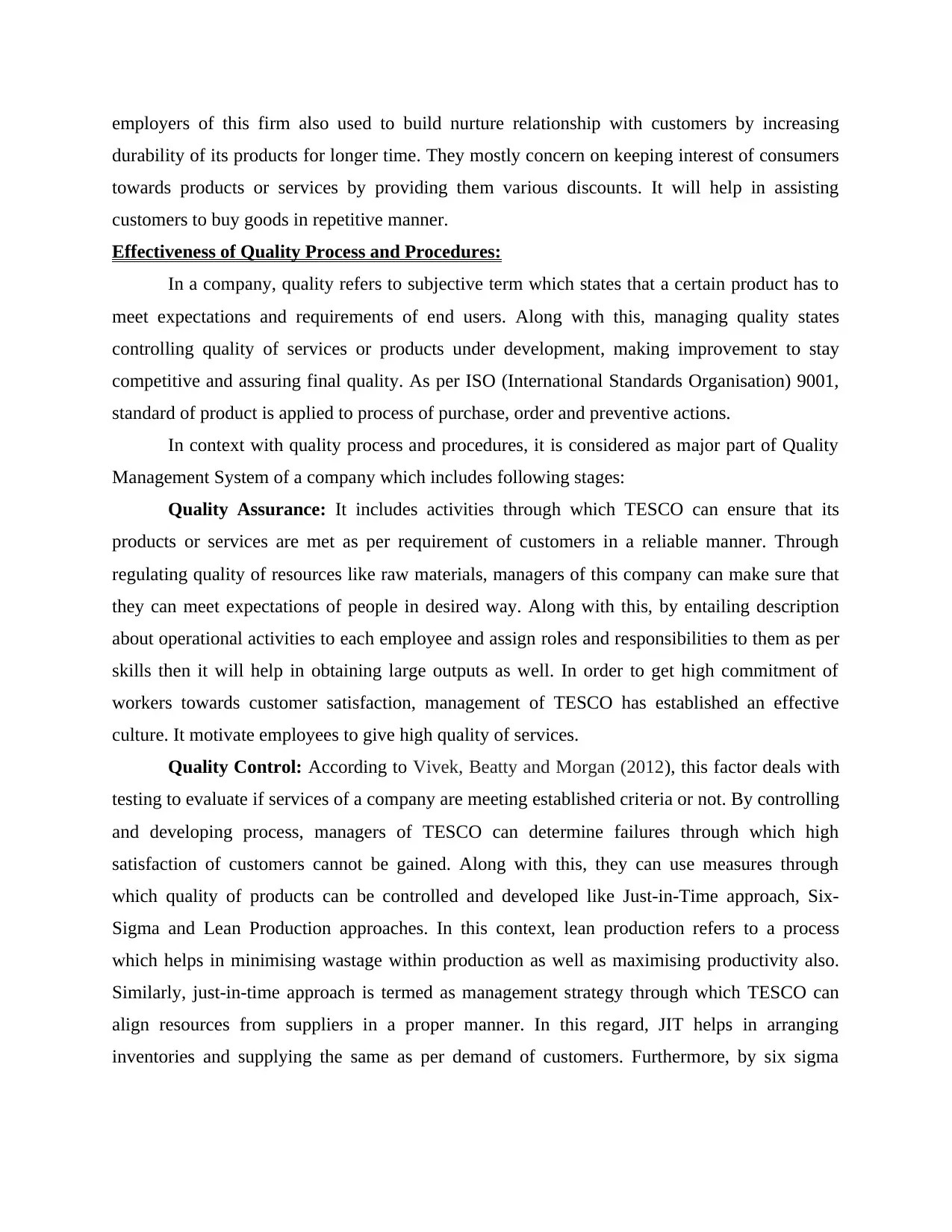
employers of this firm also used to build nurture relationship with customers by increasing
durability of its products for longer time. They mostly concern on keeping interest of consumers
towards products or services by providing them various discounts. It will help in assisting
customers to buy goods in repetitive manner.
Effectiveness of Quality Process and Procedures:
In a company, quality refers to subjective term which states that a certain product has to
meet expectations and requirements of end users. Along with this, managing quality states
controlling quality of services or products under development, making improvement to stay
competitive and assuring final quality. As per ISO (International Standards Organisation) 9001,
standard of product is applied to process of purchase, order and preventive actions.
In context with quality process and procedures, it is considered as major part of Quality
Management System of a company which includes following stages:
Quality Assurance: It includes activities through which TESCO can ensure that its
products or services are met as per requirement of customers in a reliable manner. Through
regulating quality of resources like raw materials, managers of this company can make sure that
they can meet expectations of people in desired way. Along with this, by entailing description
about operational activities to each employee and assign roles and responsibilities to them as per
skills then it will help in obtaining large outputs as well. In order to get high commitment of
workers towards customer satisfaction, management of TESCO has established an effective
culture. It motivate employees to give high quality of services.
Quality Control: According to Vivek, Beatty and Morgan (2012), this factor deals with
testing to evaluate if services of a company are meeting established criteria or not. By controlling
and developing process, managers of TESCO can determine failures through which high
satisfaction of customers cannot be gained. Along with this, they can use measures through
which quality of products can be controlled and developed like Just-in-Time approach, Six-
Sigma and Lean Production approaches. In this context, lean production refers to a process
which helps in minimising wastage within production as well as maximising productivity also.
Similarly, just-in-time approach is termed as management strategy through which TESCO can
align resources from suppliers in a proper manner. In this regard, JIT helps in arranging
inventories and supplying the same as per demand of customers. Furthermore, by six sigma
durability of its products for longer time. They mostly concern on keeping interest of consumers
towards products or services by providing them various discounts. It will help in assisting
customers to buy goods in repetitive manner.
Effectiveness of Quality Process and Procedures:
In a company, quality refers to subjective term which states that a certain product has to
meet expectations and requirements of end users. Along with this, managing quality states
controlling quality of services or products under development, making improvement to stay
competitive and assuring final quality. As per ISO (International Standards Organisation) 9001,
standard of product is applied to process of purchase, order and preventive actions.
In context with quality process and procedures, it is considered as major part of Quality
Management System of a company which includes following stages:
Quality Assurance: It includes activities through which TESCO can ensure that its
products or services are met as per requirement of customers in a reliable manner. Through
regulating quality of resources like raw materials, managers of this company can make sure that
they can meet expectations of people in desired way. Along with this, by entailing description
about operational activities to each employee and assign roles and responsibilities to them as per
skills then it will help in obtaining large outputs as well. In order to get high commitment of
workers towards customer satisfaction, management of TESCO has established an effective
culture. It motivate employees to give high quality of services.
Quality Control: According to Vivek, Beatty and Morgan (2012), this factor deals with
testing to evaluate if services of a company are meeting established criteria or not. By controlling
and developing process, managers of TESCO can determine failures through which high
satisfaction of customers cannot be gained. Along with this, they can use measures through
which quality of products can be controlled and developed like Just-in-Time approach, Six-
Sigma and Lean Production approaches. In this context, lean production refers to a process
which helps in minimising wastage within production as well as maximising productivity also.
Similarly, just-in-time approach is termed as management strategy through which TESCO can
align resources from suppliers in a proper manner. In this regard, JIT helps in arranging
inventories and supplying the same as per demand of customers. Furthermore, by six sigma
Paraphrase This Document
Need a fresh take? Get an instant paraphrase of this document with our AI Paraphraser
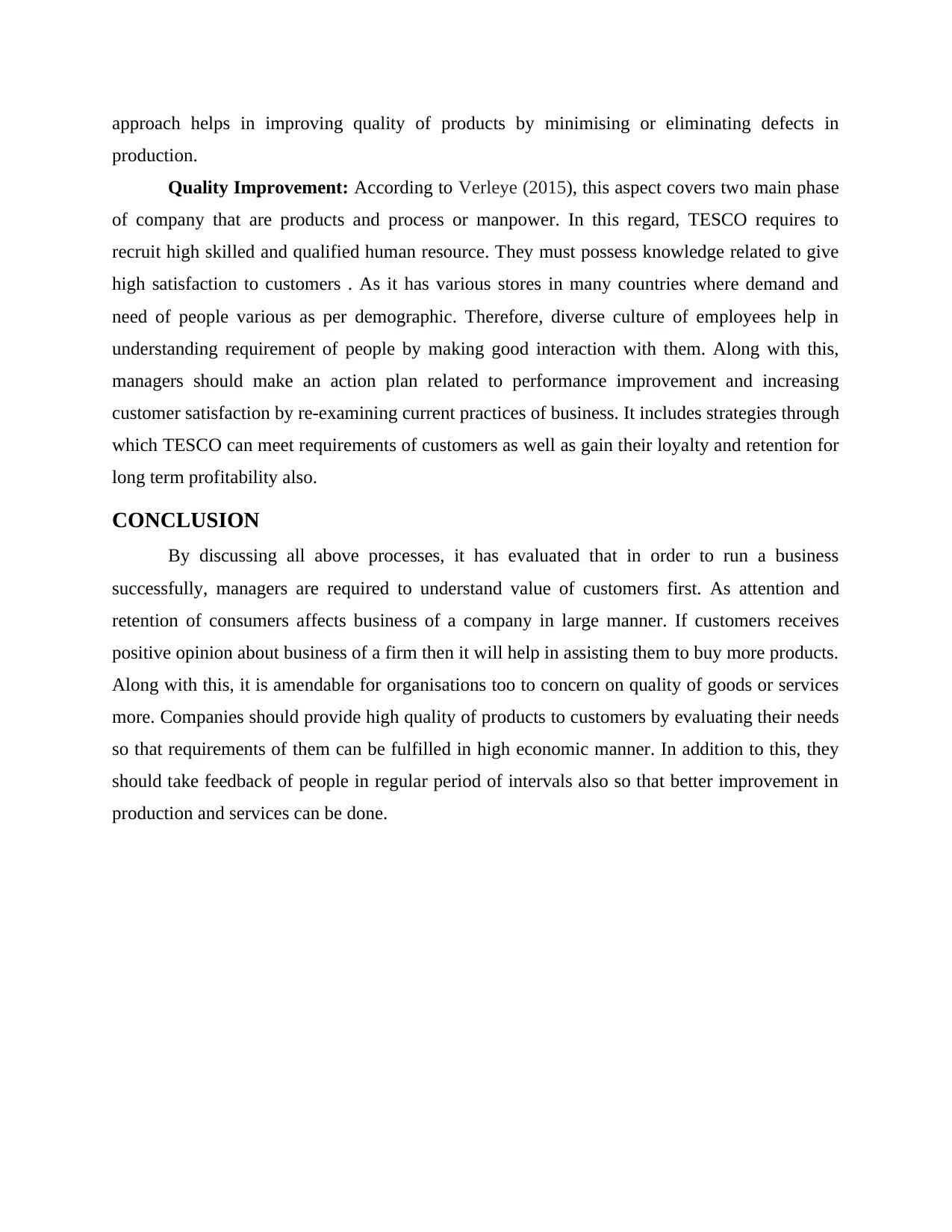
approach helps in improving quality of products by minimising or eliminating defects in
production.
Quality Improvement: According to Verleye (2015), this aspect covers two main phase
of company that are products and process or manpower. In this regard, TESCO requires to
recruit high skilled and qualified human resource. They must possess knowledge related to give
high satisfaction to customers . As it has various stores in many countries where demand and
need of people various as per demographic. Therefore, diverse culture of employees help in
understanding requirement of people by making good interaction with them. Along with this,
managers should make an action plan related to performance improvement and increasing
customer satisfaction by re-examining current practices of business. It includes strategies through
which TESCO can meet requirements of customers as well as gain their loyalty and retention for
long term profitability also.
CONCLUSION
By discussing all above processes, it has evaluated that in order to run a business
successfully, managers are required to understand value of customers first. As attention and
retention of consumers affects business of a company in large manner. If customers receives
positive opinion about business of a firm then it will help in assisting them to buy more products.
Along with this, it is amendable for organisations too to concern on quality of goods or services
more. Companies should provide high quality of products to customers by evaluating their needs
so that requirements of them can be fulfilled in high economic manner. In addition to this, they
should take feedback of people in regular period of intervals also so that better improvement in
production and services can be done.
production.
Quality Improvement: According to Verleye (2015), this aspect covers two main phase
of company that are products and process or manpower. In this regard, TESCO requires to
recruit high skilled and qualified human resource. They must possess knowledge related to give
high satisfaction to customers . As it has various stores in many countries where demand and
need of people various as per demographic. Therefore, diverse culture of employees help in
understanding requirement of people by making good interaction with them. Along with this,
managers should make an action plan related to performance improvement and increasing
customer satisfaction by re-examining current practices of business. It includes strategies through
which TESCO can meet requirements of customers as well as gain their loyalty and retention for
long term profitability also.
CONCLUSION
By discussing all above processes, it has evaluated that in order to run a business
successfully, managers are required to understand value of customers first. As attention and
retention of consumers affects business of a company in large manner. If customers receives
positive opinion about business of a firm then it will help in assisting them to buy more products.
Along with this, it is amendable for organisations too to concern on quality of goods or services
more. Companies should provide high quality of products to customers by evaluating their needs
so that requirements of them can be fulfilled in high economic manner. In addition to this, they
should take feedback of people in regular period of intervals also so that better improvement in
production and services can be done.
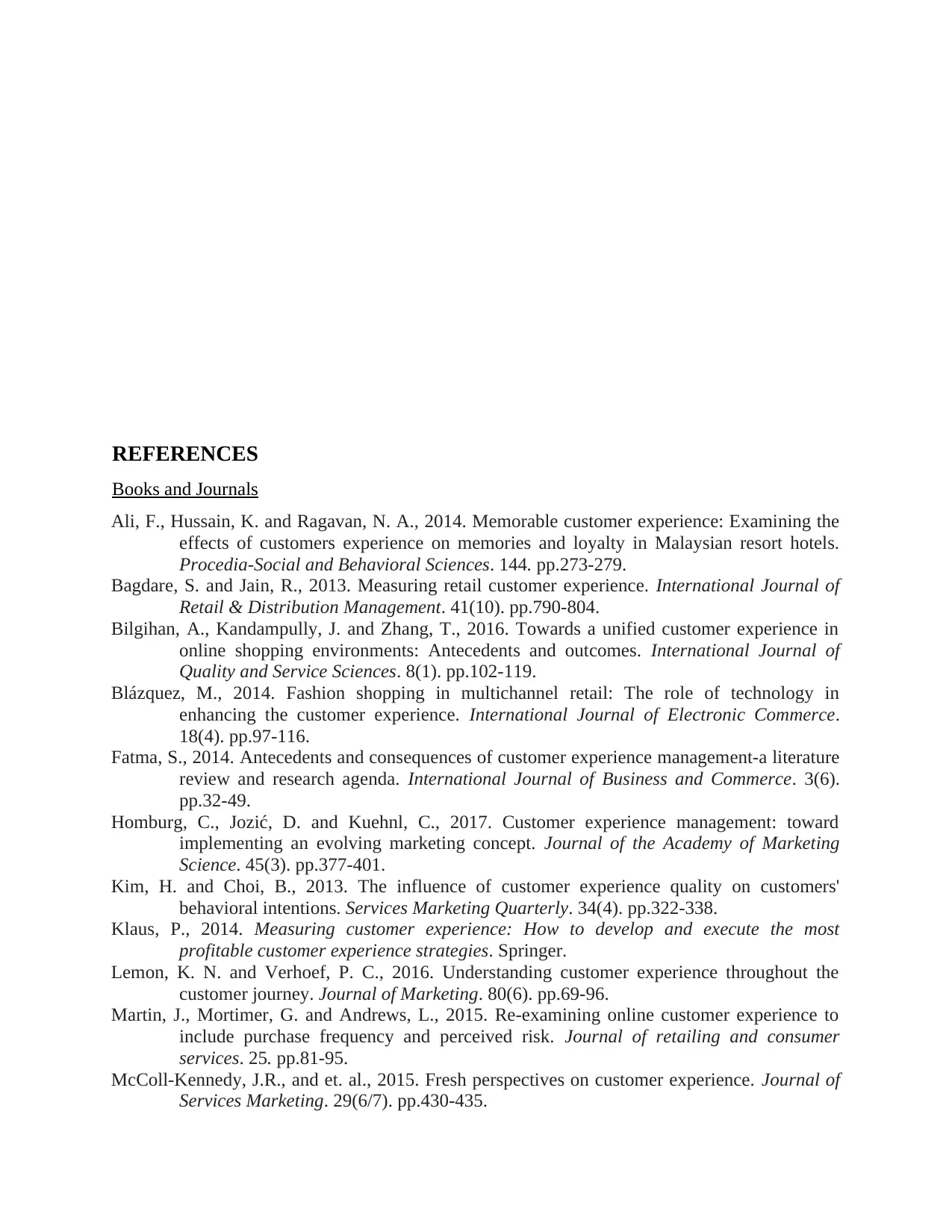
REFERENCES
Books and Journals
Ali, F., Hussain, K. and Ragavan, N. A., 2014. Memorable customer experience: Examining the
effects of customers experience on memories and loyalty in Malaysian resort hotels.
Procedia-Social and Behavioral Sciences. 144. pp.273-279.
Bagdare, S. and Jain, R., 2013. Measuring retail customer experience. International Journal of
Retail & Distribution Management. 41(10). pp.790-804.
Bilgihan, A., Kandampully, J. and Zhang, T., 2016. Towards a unified customer experience in
online shopping environments: Antecedents and outcomes. International Journal of
Quality and Service Sciences. 8(1). pp.102-119.
Blázquez, M., 2014. Fashion shopping in multichannel retail: The role of technology in
enhancing the customer experience. International Journal of Electronic Commerce.
18(4). pp.97-116.
Fatma, S., 2014. Antecedents and consequences of customer experience management-a literature
review and research agenda. International Journal of Business and Commerce. 3(6).
pp.32-49.
Homburg, C., Jozić, D. and Kuehnl, C., 2017. Customer experience management: toward
implementing an evolving marketing concept. Journal of the Academy of Marketing
Science. 45(3). pp.377-401.
Kim, H. and Choi, B., 2013. The influence of customer experience quality on customers'
behavioral intentions. Services Marketing Quarterly. 34(4). pp.322-338.
Klaus, P., 2014. Measuring customer experience: How to develop and execute the most
profitable customer experience strategies. Springer.
Lemon, K. N. and Verhoef, P. C., 2016. Understanding customer experience throughout the
customer journey. Journal of Marketing. 80(6). pp.69-96.
Martin, J., Mortimer, G. and Andrews, L., 2015. Re-examining online customer experience to
include purchase frequency and perceived risk. Journal of retailing and consumer
services. 25. pp.81-95.
McColl-Kennedy, J.R., and et. al., 2015. Fresh perspectives on customer experience. Journal of
Services Marketing. 29(6/7). pp.430-435.
Books and Journals
Ali, F., Hussain, K. and Ragavan, N. A., 2014. Memorable customer experience: Examining the
effects of customers experience on memories and loyalty in Malaysian resort hotels.
Procedia-Social and Behavioral Sciences. 144. pp.273-279.
Bagdare, S. and Jain, R., 2013. Measuring retail customer experience. International Journal of
Retail & Distribution Management. 41(10). pp.790-804.
Bilgihan, A., Kandampully, J. and Zhang, T., 2016. Towards a unified customer experience in
online shopping environments: Antecedents and outcomes. International Journal of
Quality and Service Sciences. 8(1). pp.102-119.
Blázquez, M., 2014. Fashion shopping in multichannel retail: The role of technology in
enhancing the customer experience. International Journal of Electronic Commerce.
18(4). pp.97-116.
Fatma, S., 2014. Antecedents and consequences of customer experience management-a literature
review and research agenda. International Journal of Business and Commerce. 3(6).
pp.32-49.
Homburg, C., Jozić, D. and Kuehnl, C., 2017. Customer experience management: toward
implementing an evolving marketing concept. Journal of the Academy of Marketing
Science. 45(3). pp.377-401.
Kim, H. and Choi, B., 2013. The influence of customer experience quality on customers'
behavioral intentions. Services Marketing Quarterly. 34(4). pp.322-338.
Klaus, P., 2014. Measuring customer experience: How to develop and execute the most
profitable customer experience strategies. Springer.
Lemon, K. N. and Verhoef, P. C., 2016. Understanding customer experience throughout the
customer journey. Journal of Marketing. 80(6). pp.69-96.
Martin, J., Mortimer, G. and Andrews, L., 2015. Re-examining online customer experience to
include purchase frequency and perceived risk. Journal of retailing and consumer
services. 25. pp.81-95.
McColl-Kennedy, J.R., and et. al., 2015. Fresh perspectives on customer experience. Journal of
Services Marketing. 29(6/7). pp.430-435.
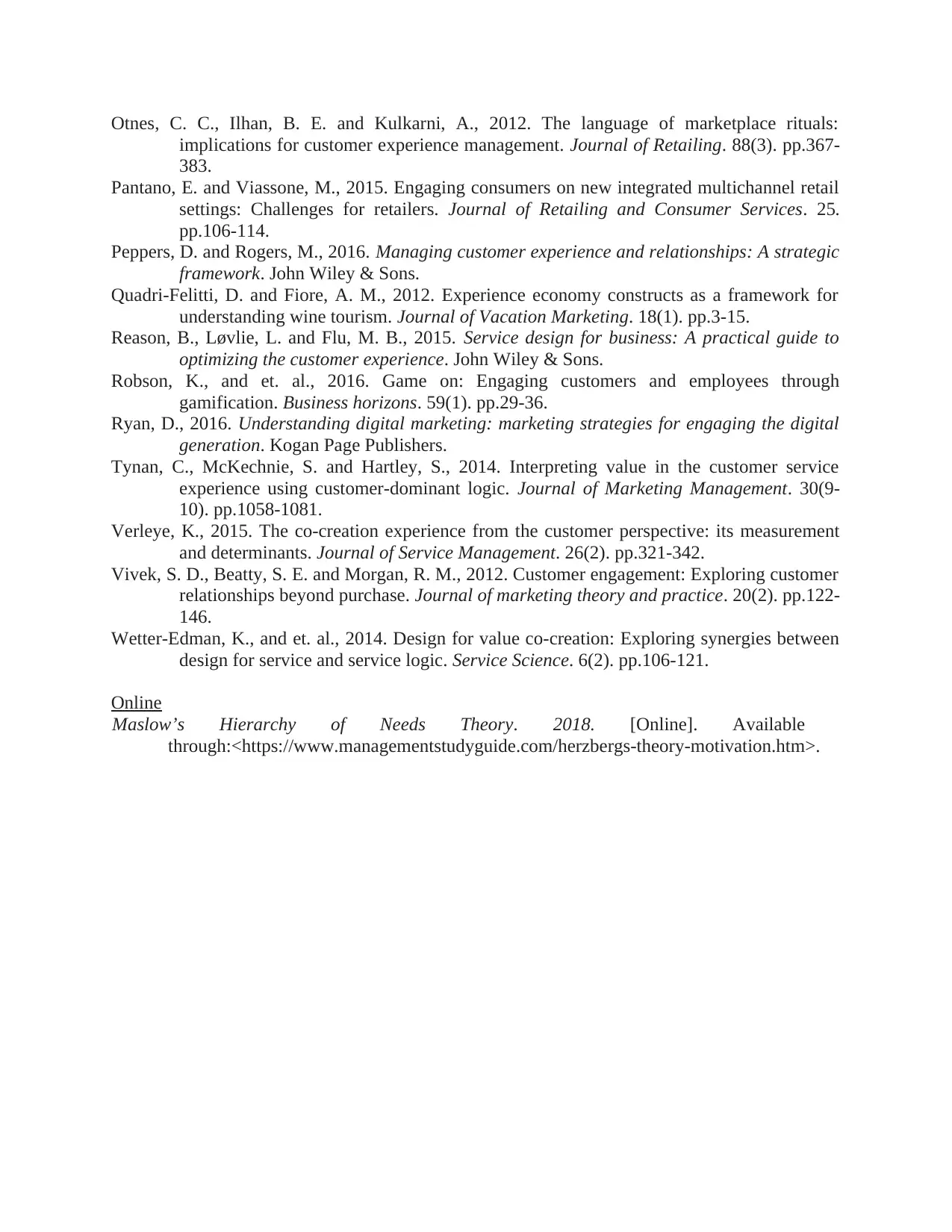
Otnes, C. C., Ilhan, B. E. and Kulkarni, A., 2012. The language of marketplace rituals:
implications for customer experience management. Journal of Retailing. 88(3). pp.367-
383.
Pantano, E. and Viassone, M., 2015. Engaging consumers on new integrated multichannel retail
settings: Challenges for retailers. Journal of Retailing and Consumer Services. 25.
pp.106-114.
Peppers, D. and Rogers, M., 2016. Managing customer experience and relationships: A strategic
framework. John Wiley & Sons.
Quadri-Felitti, D. and Fiore, A. M., 2012. Experience economy constructs as a framework for
understanding wine tourism. Journal of Vacation Marketing. 18(1). pp.3-15.
Reason, B., Løvlie, L. and Flu, M. B., 2015. Service design for business: A practical guide to
optimizing the customer experience. John Wiley & Sons.
Robson, K., and et. al., 2016. Game on: Engaging customers and employees through
gamification. Business horizons. 59(1). pp.29-36.
Ryan, D., 2016. Understanding digital marketing: marketing strategies for engaging the digital
generation. Kogan Page Publishers.
Tynan, C., McKechnie, S. and Hartley, S., 2014. Interpreting value in the customer service
experience using customer-dominant logic. Journal of Marketing Management. 30(9-
10). pp.1058-1081.
Verleye, K., 2015. The co-creation experience from the customer perspective: its measurement
and determinants. Journal of Service Management. 26(2). pp.321-342.
Vivek, S. D., Beatty, S. E. and Morgan, R. M., 2012. Customer engagement: Exploring customer
relationships beyond purchase. Journal of marketing theory and practice. 20(2). pp.122-
146.
Wetter-Edman, K., and et. al., 2014. Design for value co-creation: Exploring synergies between
design for service and service logic. Service Science. 6(2). pp.106-121.
Online
Maslow’s Hierarchy of Needs Theory. 2018. [Online]. Available
through:<https://www.managementstudyguide.com/herzbergs-theory-motivation.htm>.
implications for customer experience management. Journal of Retailing. 88(3). pp.367-
383.
Pantano, E. and Viassone, M., 2015. Engaging consumers on new integrated multichannel retail
settings: Challenges for retailers. Journal of Retailing and Consumer Services. 25.
pp.106-114.
Peppers, D. and Rogers, M., 2016. Managing customer experience and relationships: A strategic
framework. John Wiley & Sons.
Quadri-Felitti, D. and Fiore, A. M., 2012. Experience economy constructs as a framework for
understanding wine tourism. Journal of Vacation Marketing. 18(1). pp.3-15.
Reason, B., Løvlie, L. and Flu, M. B., 2015. Service design for business: A practical guide to
optimizing the customer experience. John Wiley & Sons.
Robson, K., and et. al., 2016. Game on: Engaging customers and employees through
gamification. Business horizons. 59(1). pp.29-36.
Ryan, D., 2016. Understanding digital marketing: marketing strategies for engaging the digital
generation. Kogan Page Publishers.
Tynan, C., McKechnie, S. and Hartley, S., 2014. Interpreting value in the customer service
experience using customer-dominant logic. Journal of Marketing Management. 30(9-
10). pp.1058-1081.
Verleye, K., 2015. The co-creation experience from the customer perspective: its measurement
and determinants. Journal of Service Management. 26(2). pp.321-342.
Vivek, S. D., Beatty, S. E. and Morgan, R. M., 2012. Customer engagement: Exploring customer
relationships beyond purchase. Journal of marketing theory and practice. 20(2). pp.122-
146.
Wetter-Edman, K., and et. al., 2014. Design for value co-creation: Exploring synergies between
design for service and service logic. Service Science. 6(2). pp.106-121.
Online
Maslow’s Hierarchy of Needs Theory. 2018. [Online]. Available
through:<https://www.managementstudyguide.com/herzbergs-theory-motivation.htm>.
1 out of 16
Related Documents
Your All-in-One AI-Powered Toolkit for Academic Success.
+13062052269
info@desklib.com
Available 24*7 on WhatsApp / Email
![[object Object]](/_next/static/media/star-bottom.7253800d.svg)
Unlock your academic potential
© 2024 | Zucol Services PVT LTD | All rights reserved.





